![]()
![]()
![]()
Group & Last Name Index to Full History:
A B C D E F G H I J K L M N O P Q R S T U V W X Y Z
Composers are listed chronologically. Tracks are listed alphabetically.
Find on Page = F3. Not on this page? See history tree below.
Alphabetical
Chronological
Featured on this page in order of the composer's birth date.
| 1692 | Giuseppe Tartini |
| 1694 | Louis-Claude Daquin |
| 1695 | Giuseppe Sammartini |
| 1698 | Metastasio |
| 1700 | Giovanni Sammartini |
| 1703 | Georg Andreas Sorge |
| 1704 | Giovanni Battista Pescetti |
| 1706 | Giovanni Battista Martini |
| 1709 | Franz Xaver Richter |
| 1710 | Wilhelm Friedemann Bach |
| 1712 | Frederick II Jean-Jacques Rousseau |
| 1714 | Christoph Willibald Gluck Niccolò Jommelli |
| 1716 | Josef Seger |
| 1717 | Johann Stamitz |
| 1718 | Friedrich Wilhelm Marpurg |
| 1722 | Jiří Antonín Benda |
| 1723 | Carl Friedrich Abel |
| 1727 | Armand-Louis Couperin |
| 1728 | Niccolò Piccinni |
| 1731 | |
| 1732 | Franz Joseph Haydn Johann Christoph Friedrich Bach |
| 1735 | Johann Christian Bach |
| 1736 | Johann Georg Albrechtsberger |
| 1737 | Josef Mysliveček Johann Michael Haydn |
| 1738 | Leopold Hofmann |
| 1745 | Carl Stamitz |
| 1747 | Leopold Koželuch |
| 1750 | Antonio Salieri |
| 1751 | Jan Křtitel Kuchař |
| 1756 | Wolfgang Amadeus Mozart Karel Blažej Kopřiva |
| This page indexes the
Galant [1,
2,
3]
and Classical periods of classical music beginning w composers who bridged
from the Baroque. Galant is the brighter and lighter version of baroque
transitioning toward classical. The Classical period is generally considered
to stretch from 1730 to 1820 w the Baroque sometimes dated
to as late as 1750. The Galant merges into those time frames as a
sibling of Rococo in art and architecture [1,
2,
3,
4,
5],
also to coincide w the European Age of Enlightenment [1,
2,
3,
4,
5].
Among the more apt examples of galant may be the composer, Georg Christoph
Wagenseil [b 1715 d 1777: 1,
2;
audio].
See also 'Music in European Capitals: The Galant Style, 1720-1780' by
Daniel Heartz (WW Norton & Company 2003); 'Opera in the Age of Rousseau' by
David Charlton (Cambridge U Press 2012);
'Chronology of the Classical Era'.
The classical pages are structured
differently from the other YouTube histories. Due that specific dates are
largely impossible with early classical music we keep the convention of
indexing works on those pages by alphabetical order only. That is, they are
not in chronological order. Dates are noted by appendage and refer the year
of publication if not composition. As for brackets (: [Part 1]), they indicate sections made
by YouTube channels. If the composer you're seeking isn't on this page he
may bridge Baroque or
Romantic. As the history of classical music is largely European until its later
arrival to the United States in the 19th century, helpful in the use of these
accounts may be chronological maps of Europe and its monarchs mentioned
throughout [1,
2,
3,
4]. The
earliest major European temporal power to which this history refers
throughout is the Roman Catholic Church and the
Papal States. Much of the
history of Europe is likewise that of the Holy Roman Empire (HRE) from the 9th
to the 19th centuries [1,
2,
3;
HMEA].
France
was a major player alongside the
Church in medieval music prior to the Renaissance and
became the major European check to the HRE. Venice didn't acquire a lot of territory
but became a major cultural center during the Renaissance alike
Italy
of which it became a part in 1866. Other
European nations important to these accounts include in alphabetical order
Austria,
England [GB UK: 1,
2],
Germany,
Poland [1,
2],
Prussia [1,
2],
Russia and
Spain. Also
much affecting European music was northern Europe or, Scandinavia
[1,
2,
3],
particularly as an adversarial check to Russia.
Quick dates for monarchs and popes:
1,
2,
3,
4. See also America [1,
2]. As for music,
one among numerous good locations to source audio is Idagio.
|
||
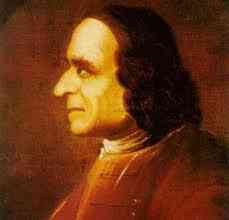 Giuseppe Tartini Source: Mythologia |
Born in Piran in
which is in the Republic of Venice (present-day Slovenia) on 6 April 1692,
Giuseppe Tartini
bridges the Baroque to Classical periods. He
received his elemental education, including music, from Franciscans. While
later studying law at the University of Padua Tartini pursued the martial
art of fencing. In 1710 he married trouble in Elisabetta Premazone. As she
was the mistress of Cardinal Giorgio Cornaro, Tartini faced charges of
abduction, from which he fled to the Franciscan monastery in Assisi. He
there began to study the violin. Though scholars believe it to be of a later
date, Tartini has written of composing his famous Sonata in G Minor, 'Il
Trillo del Diavolo' [1,
2,
3,
4], as early as 1713. He became the first known owner of a violin
made by Antonio Stradivari in 1715 [Stradivari: 1,
2,
3,
4,
5,
6]. In 1716 he went to Ancona to work in
that city's opera orchestra. 1721 found him Maestro di Cappella at the
Basilica di Sant'Antonio in Padua. He opened a music school in 1726. Tartini
is famous as a music theorist for "Tartini's Tones" or, combination tones
that are the creation of a third tone by the simultaneous production of two
other tones. He thusly examined acoustics and temperament in a treatise
published in 1754 titled 'Trattato di musica secondo la vera scienza
dell'armonia' [1,
2,
3,
4,
5,
6].
Albeit
Georg Andreas Sorge
published the same discovery in 1745-47 in his 3-volume 'Vorgemach Der
Musicalischen Composition', Tartini comments that he learned of combination
tones as early as 1714. Other close contemporaries of Tartini who were also
music theorists include
JS Bach,
Rameau and the much younger
Marpurg. Tartini is thought to have composed his 'Stabat Mater in F Major'
[1,
2,
3] in 1769
shortly before his death, that published in 'Secunda Anthologia Vocalis' by
Oreste Ravanello in 1903 [1,
2]. Tartini died the next year on 26 Feb 1770. Among his works
were a number of
symphonies along with loads violin concerti and sonatas.
References: 1,
2,
3,
4,
5
(alt),
6.
Scores: 1,
2.
Editions: 1,
2,
3.
Audio: 1,
2,
3,
4.
Discos: 1,
2,
3,
4,
5.
Further reading: IstriaNet;
C. Sminthe.
Other profiles: 1,
2,
3.
Bibliography: 'Tartini and Combination Tones' by Bruno Ravnikar.
B numbers below are per Paul Brainard 1959. D numbers are Minos Dounias as
of 1935. Giuseppe Tartini B G1 Quartus Chamber Players D 88 Allegro Violin: Federico Guglielmo D 17 Adagio Orfeo Orchestra György Vashegyi Violin: László Paulik 1731? B G17 Violin: Fabio Biondi 'Didone abbandonata' 1731? B G10 The Palladians 'Le trille du diable' 1799 B G5 James Levine & Wiener Philharmonike Violin: Anne-Sophie Mutter |
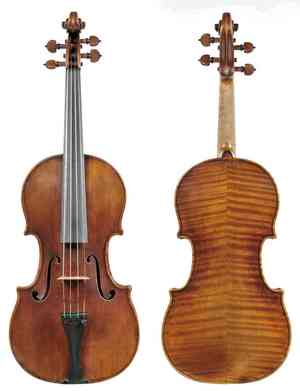 Tartini's Stradivarius Source: A Violin's Life |
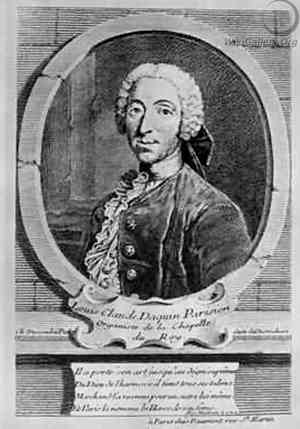 Louis-Claude Daquin Source: Wiki Gallery |
Born in Paris on 4 July 1694,
Louis-Claude Daquin was a
keyboard virtuoso most
remembered for his noels. Noels had developed out of the motet (sacred
polyphonic songs) composed especially for Christ Mass since the 13th century
(though the first mention of "Christ Mass" was in 1038, very likely
accompanied with chant or hymn, that about the time hymns began replacing
the Gregorian chant). The term's first use is thought to be circa 1420 by
composer, Nicolas Grenon. Daquin composed in both the baroque and galant
manner. The galant period [1,
2,
3] in music (1710
to 1770) had its sibling in architecture and art known as the rococo [1,
2,
3,
4,
5]. One might think
of galant as light and elegant baroque, returning it to its origins of above
a century earlier around 1600 when its aim had been to rescue composition
from such as complex polyphonies while lending elegance and meaning through
song via which opera had become the new vehicle. Daquin's father, a painter, is said
to have wrought a prodigy, Daquin performing at the court of King Louis XIV
of France at age six. Two years later he conducted his choral work, 'Beatus Vir'. He was for a time a pupil of
Louis Marchand.
At age twelve Daquin became organist at the Sainte-Chapelle, the following
year at the Church of Petit Saint Antoine. 1727 found him an organist at the
Church of Saint Paul, 1732 at the Church of the Cordeliers. In 1739 he
became organist to King Louis XV at the Chapelle Royale. Like a frog always
seeming to land on the nicest pads, he became organist at Notre-Dame
Cathedral in 1755. Daquin died on 15 June 1772.
References: 1,
2.
Scores: 1,
2.
Editions: 1,
2,
3.
Audio: 1,
2,
3.
Discos: 1,
2,
3,
4.
Other profiles: 1,
2. Louis-Claude Daquin Organ: Olivier Baumont Troisième Suite: Le Coucou 1735 Harpsichord: Ernst Stolz Deuxième Suite: L'Hirondelle 1735 Harpsichord: Olivier Baumont Troisième Suite: Le Coucou 1735 Harpsichord: George Malcolm |
|
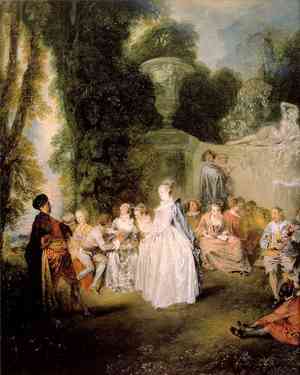 Venetian Pleasure 1718 Jean-Antoine Watteau Source: 1st Art Gallery 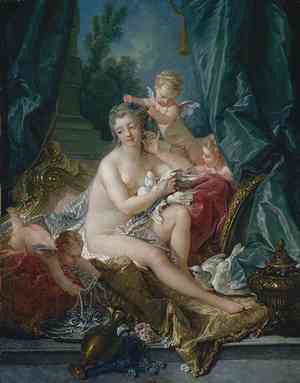 The Toilette of Venus 1751 François Boucher Source: Met Museum 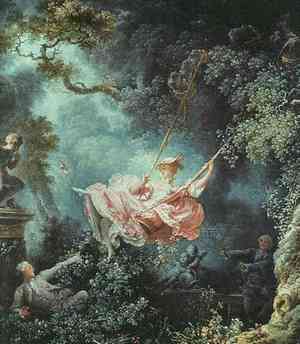 The Swing 1767 Jean-Honoré Fragonard Source: Nancy Zhang |
Born in Milan on 6 Jan 1695,
Giuseppe Baldassare Sammartini
was an oboist and elder brother to
Giovanni Battista Sammartini.
Earliest records find him at St. Celso's in 1717 as an oboist, likely flute
and recorder as well. Three years later he was playing the instrument at
the Teatro Regio Ducal. In 1729 he headed for Brussels, then London, where
the publishing of his '12 Trio Sonatas' had preceded him since 1727. Prince
Frederick of Wales became Sammartini's patron in 1736 until his death in
November of
1750. Like
Daquin,
Sammartini ventured into the galant style, and like
Scarlatti his
sonatas were influential to the blossoming of the classical. Not only was
Sammartini reasonably popular during his time, but he became more
well-regarded since then, though in modern times is a minor composer not
widely known. Most of his oeuvre
surviving, Sammartini wrote 24 sonatas for flute and bass, 30 trios for
flute or violin, 24 concerti grossi, 4 keyboard concertos, 1 oboe concerto,
16 overtures, and some cello sonatas and flute duets.
References for Sammartini: 1,
2.
Scores.
Editions.
Audio.
Discographies: 1,
2,
3,
4,
5.
HMR Project. The galant period
[1,
2,
3] in
music was quite brief in comparison to rococo in art and architecture.
Fitting well inside the Rococo period [1,
2,
3,
4,
5], the galant in music is yet much associated with
rococo. To the left are paintings by three important rococo painters who
were contemporaneous with Sammartini. Watteau was born eleven years earlier
than Sammartini. Boucher was born eight years later, Fragonard not until
1732. To the right is the rococo interior at the Ottobeuren Basilica in
Bavaria, an example of rococo interior design and the summer palace of
Russian Empress Elizabeth. It stands where Catherine I had built a
prior palace in 1717. Elizabeth thought that palace so worthless that she
had it demolished to make room for something more to her tastes in 1733. Giuseppe Sammartini Concerto for Recorder & Strings in F major [Part 1] Recorder: Clara Cowley Orquestra Ars Musicae de Mallorca Concerto for Recorder & Strings in F major [Part 2] Recorder: Clara Cowley Orquestra Ars Musicae de Mallorca Harpsichord Concerto in A major Flute Concerto in D major Flute Concerto in A major Oboe Concerto 9 in B flat major Oboe Concerto 12 in C major I Misici Ambrosiani/Paolo Suppa Flute: Paolo Ferrigato Harpsichord: Donatella Bianchi Oboe: Francesco Quaranta Harpsichord Concerto in A major I Musici Ambrosiani/Michele Suppa Harpsichord: Donatella Bianchi Batzdorfer Hofkapelle/Daniel Deuter Oboe: Xenia Löffler Les Muffatti/Peter Van Heyghen Oboe: Benoit Laurent I Fiori Musicali/Maria Giovanna Fiorentino Allegro Gerda Fisk
|
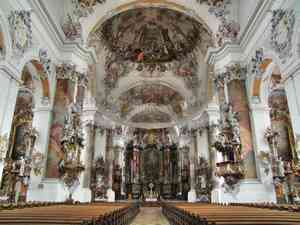 Ottobeuren Basilica in Bavaria Source: Wonder Mondo 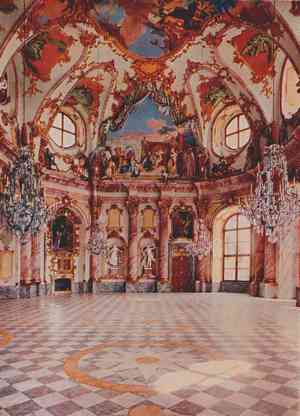 Rococo Interior Source: emily2217 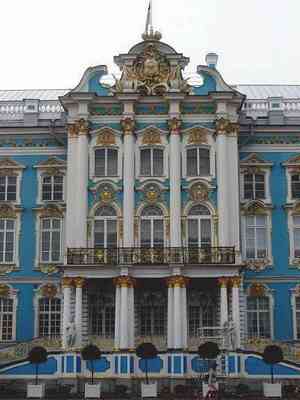 Empress Elizabeth's Summer Palace |
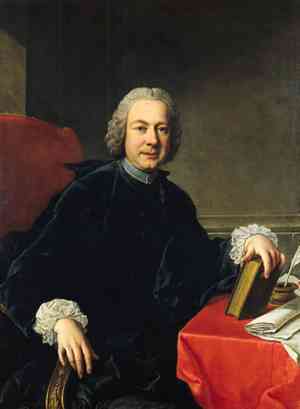 Metastasio Painting: Martin van Meytens Source: Wikipedia |
One librettist in particular demands attention,
sitting big and fat in the middle of Baroque Avenue, that Pietro Antonio Domenico Trapassi better known as Metastasio.
Metastasio's career began amidst the Baroque, spanned to the Classical period and
was influential
to the Romantic. Master of opera seria, Metastasio was born in Rome on 3 Jan 1698 to a father once a soldier in papal
forces become a grocer. A precocious child, Metastasio
entertained on the streets with impromptu verses on subjects suggested by
his audiences in what is know as improvisational poetry, imagining numerous
stanzas at a time. One such performance won him the adoptive care of Giovanni
Vincenzo Gravina, an eminent lawyer and founder of the literary Arcadian
Academy. This also brought Metastasio an education in jurisprudence and
Latin that his father alone could in no way swing. It was Gravina from whom
Metastasio got his name, an Hellenization of his actual name which was Trepassi. Gravina took his
prodigy to Naples, then entered Metastasio into the care of Gregorio
Caroprese in Scaléa. At age twelve, Metastasio translated Homer's 'Iliad' into octave
stanzas. He wrote his first tragedy, 'Giustino' [1,
2], two years later. It saw
publishing in 1717 despite Metastasio's dislike of it as a juvenile work. Caroprese died in 1714. Upon Gravina's death in 1718 Metastasio found
himself with fifteen thousand scudi. If you consider that 15,000 scudi could
buy you several very nice houses, or a casino, you could say Metastasio
might have retired at age twenty. But he spent it in a couple of years, so
entered the legal profession. A few years later he premiered his serenata 'L'Angelica',
also referred to as 'Angelica e Medoro', on 28 August 1720 in Naples,
setting by
João de Sousa Carvalho
[1,
2,
3
(pdf);
text].
Metastasio had borrowed from Ariosto's 'Orlando Furioso' for that, borrowed
itself from Matteo Maria Boiardo's 'Orlando Innamorato'. 'L'Angelica' in celebration of the 29th birthday of
Elizabeth Christine, it was also the stage debut of fifteen year-old castrato, Farinelli
[1,
2,
3],
among the more famous singers in opera history. Castration was nothing
new in music. Beginning as a means of subjugating slaves, eunuchs were
employed in choirs in Constantinople as early as circa 400 AD. Castrati,
more politely called musici, were to opera what good bass singers were to
barbershop or doo wop in the 20th century w the exception that musici were
the glamor pigs of their age, more politely called stars, nor the
stardom of only a popular baritone in a vocal group, but big, as in
'Fame'. Most castrati saw the knife between the
ages of eight and twelve. Getting snipped was dangerous, but were you
desperately poor at age ten the huge gamble on becoming a star, which only a
few of the thousands who saw surgery did, could look better than present
actualities. The delicacy of a musico's high pitch delivered
with adult lungs was among the attractions of opera throughout its
history, existing into the 20th century though largely falling away in the
19th. [References for castrati: 1,
2,
3,
4,
5,
6,
7,
8,
9;
Hektoen International: 1,
2;
The Smart Set,
Wikipedia.]
As for Metastasio, his serenata, 'L'Endimione', premiered on 9 June 1721 in
Naples w its setting composed by Domenico Sarro
[*; text:
1,
2,
3].
That was an epithalamium
dedicated to Marianna Pignatelli
[1,
2]
in celebration of the wedding of Antonio Pignatelli, Prince of Belmonte, to Anna Pinelli di Sangro. An epithalamium
is a poem written for a bride on
her way to the marital chamber. Marianna Pignatelli
[1,
2,
3
(alt)]
was a Spanish aristocrat who would play an important role in Metastasio's life as his main line to nobility. Pignatelli was mistress to
Holy Roman Emperor Charles VI
who had arranged her 1712 marriage to the Count of Althann, the latter dying
in 1722. Pignatelli would later gain Metastasio a position at Charles' court
(below), they also to fashion a romantic relationship. The premiere of Metastasio's serenata, 'Gli
orti esperidi', was 28 August 1721, another birthday celebration for
Elizabeth Christine (above), now her 30th, w setting by
Porpora
[1,
2]. 'The
Gardens of the Hesperides'
won Metastasio quarters in the home of soprano,
Marianna Bulgarelli,
in Rome in 1722, she having played the role of Venus. Metastasio's 'Didone Abbandonata', an opera w setting by
Sarro and
title role filled by
Bulgarelli,
premiered during Carnival in Naples on 2 Feb 1724
[1,
2,
3]. That was a highly popular
libretto which saw continuous presentations as other composers created new
settings for it (Albinoni,
Porpora,
Vinci, et al).
During the twenties Metastasio averaged about 300 scudi per opera, which was
nothing to sniffle about, yet limiting nevertheless. He therefore went to Vienna in 1730
to become court poet to Holy Roman Emperor Charles VI,
assisted in that by Pignatelli (above). Metastasio's opera, 'Demetrio' [*;
text],
premiered on 4 November of 1731 in a setting by
Antonio Caldera [1,
2,
3,
4]
who had five years left to live. Come the opera, 'The Olimpiad', on 28
August 1731 w music again by Caldera
[*;
text].
Caldera and Metastasio also collaborated on the opera, 'Demofoonte'
[*;
text], first
performed on 4 November 1733. Metastasio
was left yet another fortune when
Bulgarelli
suddenly died in 1734. Not expecting such
generosity, he renounced it, feeling guilt for ill feelings he'd had against
her. The serpent of the thing is that the fortune then went to Bulgarelli's
surviving husband who married again, while Metastasio's own father, brother
and sister struggled. Come another birthday celebration on 1 October
1735, now for the fiftieth year of Charles VI (above) in the one-act 'Il Sogno di Scipione' w music by Luca Antonio
Predieri
[*; text:
1,
2].
Mozart later wrote a setting for 'Il Sogno di Scipione' about
1771 (K 126:
audio).
Charles died in 1740 but Metastasio's relationship w Countess Althann
continued to her death in 1755, during which time he largely retired from
writing until his own death much later on 12 April 1782,
leaving a legacy of 130,000 florins. These days 130,000 florins approach
about $73,000; in Metastasio's day it approached huge wealth like poets
don't commonly experience. Metastasio wasn't a Shakespeare in terms of
literature, but he remains an imposing figure in the history of opera, his
work illuminating
stages in the Holy Roman Empire for several decades the way Shakespeare had
earlier owned London theatre. Providing lyric for operas, oratorios,
cantatas, canzonettas, et al, Metastasio's works had been
translated into French, English, German, Spanish and modern Greek during his
lifetime.
References: 1,
2,
3,
4.
Works: 1,
2,
3,
4.
Publications.
Editions: 1,
2,
3;
Forgotten Books: 1,
2.
Texts:
'Three Melodramas by Pietro Metastasio' (U Press of Kentucky 2015).
Recordings of: 'L’Angelica' w setting by João de Sousa
Carvalho;
'Il Sogno di Scipione' w setting by
Mozart.
Collections.
Further reading: petition to save birthplace:
BuonaCausa;
Farinelli and:
Daniel Heartz;
'The Role of Metastasio's Libretti in the Eighteenth Century: Opera as Propaganda' by
David Kirkpatrick;
late letters of at
LOC;
'The Rehabilitation of Metastasio' by
Raymond Monelle ('Music & Letters' Oxford U Press);
Dr. Don Neville;
Mario Valente: 1,
2,
3,
4,
5.
Other profiles: 1,
2,
3,
4,
5,
6,
7.
Metastasio Son regina, e sono amante 1724 Composers: Domenico Sarro 1724 Niccolo Piccinni 1770 I Turchini di Antonio Florio Antonio Florio L'amerò, sarò costante K 208 1775 Composer: Mozart Vienna Haydn Orchestra István Kertész Soprano: Lucia Popp Violin: Eszter Perenyi Ah! non son'io K 369 1781 Composer: Mozart Academy of St. Martin in the Fields Sir Neville Marriner Sylvia McNair Da quel sembiante appresi D 688 1820 Composer: Schubert Piano: Matin Katz Tenor: Lawrence Brownlee |
|
| Born
circa 1700 in
Milan,
Giovanni Battista Sammartini
was younger brother to
Giuseppe Sammartini
(above). Sammartini is thought to have composed his first work at age
twenty-five, having learned music from his father as a child. In 1728 he
became maestro di cappella at both Sant'Ambrogio and the Congregazione del
Santissimo Entierro, remaining at the former the rest of his life.
Sammartini composed for both churches and noble houses.
Christoph Willibald Gluck
was his student from 1737 to 1741. He died on 15 January 1775 in Milan. Giovanni's was
a something similar career to that of his older brother's: he composed in
the galant style and was influential to classical composition to come. Among
his more important contributions was the development of the symphony out of
trio sonata and concerto forms, rather than the overture as it usually was.
More than 450 of Sammartini's works yet exist, including 70 symphonies,
though not a few of his compositions are lost as well.
References: 1,
2,
3.
Compositions.
Scores.
Publications.
Editions: 1,
2.
Audio: 1,
2,
3.
Discos: 1,
2,
3,
4.
Further reading: Invito a Concerto.
Biblio: 'Thematic Catalogue of the Works of Giovanni Battista Sammartini' by Newell Jenkins & Bathia Churgin (Harvard U Press 1976)
*:
reviews: Howard Brofsky,
Eugene Wolf.
Other profiles: 1,
2.
Catalogue numbers below are those of Jenkins-Churgin. Giovanni Sammartini J-C 121 Capriccio Italiano Ensemble Filippo Ravizza 1732 Dresdner Barockorchester J-C 60 1772 Accademia d'Arcadia Alessandra Rossi Lürig J-C 63 Accademia d'Arcadia Alessandra Rossi Lürig J-C 31 Accademia d'Arcadia Alessandra Rossi Lürig J-C 39 Accademia d'Arcadia Alessandra Rossi Lürig |
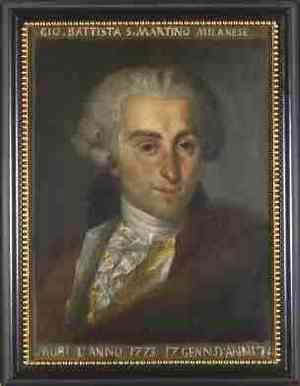 Giovanni Sammartini Painting by Domenico Riccardi 1775 Source: Il Rossignolo |
|
|
Born on 21 March 1703 in Mellenbach, Thuringia,
Georg Andreas Sorge
is more famous as a music theorist than composer. He wrote exercises and
sonatas for clavier (harpsichord, organ), fugues, choral preludes,
et al. He was hired as an organist in
1721/22 by Count Heinrich XV in Lobenstein, serving the court the
remainder of his career. Beyond his literary works little is known about
his life except that he was a
friend of
JS Bach. The
BachBib search
engine has Sorge publishing 'Clavier practice consisting of six sonatas
set according to Italian tastes' as early as circa 1736. More ubungen
(exercises) followed circa 1739, '40 and '42. In between in 1741 Sorge
published his first work in music theory, 'Genealogia allegorica
intervallorum octavae diatono-chromaticae' [1,
2,
3,
4].
In 1744 he dedicated 'Drittes halbes Dutzend Sonatinen vors Clavier und Italienischen Gusto' to
JS Bach.
Come 'XII Sonaten' circa 1745 [*].
From 1745 to '47 Sorge released three volumes of 'Vorgemach der
musicalischen composition' in which he examined his discovery of the
combination tone, that is, the creation of a third tone by the
simultaneous production of two other tones.
Giuseppe Tartini independently
discovered the same phenomenon much earlier but didn't write about it
until 'Trattato di musica secondo la vera scienza dell'armonia' in 1754.
Another work in which Sorge addressed temperament was his 1748 'Gespräch
zwischen einem Musico theoretico und einem Studioso Musices von der Prätorianischen' [1,
2,
3,
4].
He published another bunch of organ sonatas that year as well. Temperament
was the subject once again in 'Zuverlassige anweisung clavier und orgel tu
tempiren und tu stimmen' of 1758 [*].
His 'Compendium harmonicum' followed in 1760 [*]
along with his first volume concerning organ design and construction, 'Die
geheim gehaltene kunst der mensuration der orgelpfeiffen'. 'Anleitung zur
Fantasie' of 1767 addressed extemporaneous composition
[1,
2]. Sorge's last
publication is thought to have been another volume on organ design and
construction published in 1773, 'Der in der Rechen und messkunst
wohlerfahrne orgelthaumeister' [*]. Sorge died
about five years later on 4 April 1778. References for Sorge: 1,
2,
3,
4,
5,
6.
Publications: 1,
2,
3,
4.
Editions: 1,
2.
Scores: 1,
2,
3.
Audio.
Discos: 1,
2,
3,
4.
Further reading: 'The Marpurg-Sorge Controversy' by Jonathan Bernard ('Music Theory Spectrum')
*;
'David Tannenberg, Organ Builder' by Philip Cooper
*;
'Sounds of Our Times' by Robert Beyer (Tartini's tones)
*.
Biblio: 'Georg Andreas Sorge's Vorgemach Der Musicalischen Composition' by Allyn Dixon Reilly (Northwestern University 1980).
See also BMLO,
HMR Project.
References for temperament: 'Beyond Temperament' by Bruse Haynes
(pdf);
combination tones: 1,
2,
3,
4.
Georg Andreas Sorge 'Aun sich ber Tag grendet hat' 'Aun lob, mein Seel, ben herren' 'Schmucke bich, o liebe Seele' Organ: Andreas Osiander Organ: Andreas Osiander Toccata per ogni Modi [Part 1] Cembalo: Sergey Myasoedov Toccata per ogni Modi [Part 2] Cembalo: Sergey Myasoedov Toccata per ogni Modi [Part 3] Cembalo: Sergey Myasoedov |
||
|
Born circa 1704 in Venice,
Giovanni Battista Pescetti
studied under
Antonio Lotti with Baldassare Galuppi
[1,
2].
Bridging from baroque to galant and classical, he wrote mostly
operas and sonatas for clavier (harpsichord and organ). Librettists with
or of whom he composed settings include Metastasio
on numerous works.
ItalianOpera has
Pescetti's initial
opera, 'Nerone Detronato', premiering at the Teatro San Salvatore in Venice sometime in 1725.
Come 'Il Prototipo' at the Teatro San Samuele in '26 followed by 'La
Cantatrice' in 1727. Pescetti headed for London in 1736 to replace
Niccolò Porpora
as director of the Opera of the Nobility
[*] the next year. The
Opera of the Nobility had been established by
Frederick,
Prince of Wales, to rival
Handel's Royal Academy
of Music [*]
backed by
King George II. A volume of 10 sonaten for gravicembalo
(harpsichord) by Pescetti appeared in
1739 [*]. In 1747 Pescetti
returned to Venice where he taught music. It was in the vicinity of 1756
that he wrote his 'Sonata in C minor' catalogued as No.4 of '6 Keyboard
Sonatas' entered into MS I-Vc Torr.Ms.B.16 sometime between 1790 to 1799.
That is also referred to as Sonata VI (No.6) in C minor from the earlier
MS of '6 Harpsichord Sonatas' in D-Dl Mus.2967-T-1 transcribed sometime
before 1787. Pescetti was employed as second organist at
St. Mark's Basilica
from 1762 until his death on 20 March 1766.
References:
Wikipedia. Works:
1,
2,
3.
Settings of
Metastasio:
1,
2.
Digital copies:
1,
2,
3.
Editions.
Scores.
Audio:
1,
2,
3,
4.
Recordings of: discos:
1,
2,
3,
4;
'Complete Keyboard Music' by Paolo Bottini (organ):
1,
2.
Further reading: galant style and
1,
2;
Daniel Heartz;
HMR Project.
'Sonata in C minor' was transcribed for harp in 1931 by Carlos
Salzedo, performed below by Asuncion Claro.
Giovanni Pescetti Harp: Asuncion Claro |
||
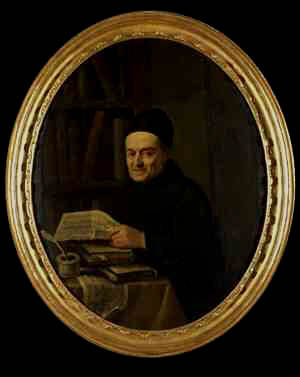 Giovanni Battista Martini Painting: Angelo Carescimbeni Source: Museo Musica Bologna |
Born on 24 April 1706 in Bologna,
Giovanni Battista Martini
had a violinist for a father who taught him the instrument. He later
studied voice, harpsichord and counterpoint. He nevertheless donned the Franciscan habit
in 1722 becoming master of the chapel in 1725 at the Basilica of San
Francesco in Bologna. He also taught and in those capacities emphasized
the Roman school. His intermezzo, 'Azione Teatrale', arrived in
1726. Martini's Opus 1 is assigned to 'Lithaniae atque antiphonae finales
B. Virginis Mariae' of 1734. His Op. 2 is '12 Sonate d'intavolatura per
l'organo e il cembalo' in 1642. His Op. 3 is '6 Sonate per l’organo ed il
cembalo' as of 1647. Martini began his history of music, 'Storia della
Musica', in 1657, a giant work of several volumes on which he proceeded
until 1681, leaving it unfinished. In 1758 Martini began teaching at the Accademia Filarmonica
di Bologna [1,
2].
Come 'Duetti da camera' in 1763. 'Saggio di contrappunto' ('Essay on
Counterpoint') arrived in two volumes in 1774-75. Martini died on 3 August 1784.
Composing both sacred and secular music, he had arrived at a
time when both opera and baroque were above a century old. Opera yet had a
couple of strong centuries to go, but baroque had drawn to a close during
Martini's lifetime. As Europe's bright cultural centers were now shared by
Italy with locations northbound such as in Germany (to speak conveniently
of the region at the time), so too did the Roman and Venetian schools,
elemental to the
Renaissance, decline in overall significance, decidedly so long since in
France. References: 1,
2,
3,
4,
5.
Works.
Facsimiles & scores: 1,
2,
3.
Editions: 1,
2.
Audio: 1,
2,
3.
Discos: 1,
2,
3,
4.
Discussion: *. Other profiles: 1,
2,
3,
4.
See also: BnF (Bibliotheque nationale de France).
Giovanni Battista Martini Organ: Stephen Mann Accademia degli Astrusi Federico Ferri Orchestra da camera Benedetto Marcello Direction: Luca Ferrara Flute: Massimo Mercelli Passion cantata Ensemble Strumentale dell'Osservanza Direction: Luigi Verdi Coro Quodlibet di Mogliano Veneto Sinfonia da camera a 4 in D major 1750 Il Rossignolo Ottaviano Terani Ensemble Cantissimo L'arpa festante Conductor: Markus Utz Soprano: Iris-Anna Deckert |
|
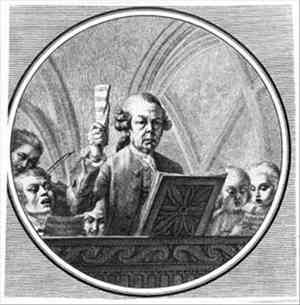 Franz Richter 1785 Engraving: Christophe Guérin |
Born in either
Bohemia or Holleschau, Moravia (now Holešov, Czech Republic) on 1 Dec 1709,
Franz Xaver Richter
doesn't show up in documents until 1740 when he was appointed deputy
kapellmeister at the Fürststift Kempten in Allgäu in southern Germany, a
Benedictine monastery now in southern Bavaria. It was common for monasteries
to have choirs, and there may have existed something of an orchestra as
well, particularly as Richter published twelve 'Grandes Symphonies' in Paris
in 1744 the year after his marriage to one Maria Anna Josepha Moz [audio
Nos. 1-6: 1,
2;
Nos. 7-12: 1,
2]. In 1746 Richter became employed as a bass singer to Holy Roman
Prince-Elector,
Charles Theodore, in Mannheim. He helped make Mannheim a
significant musical center in Germany as among the Mannheim school of
orchestration founded by
Johann
Stamitz in 1741/42 to become its director in 1750 [1,
2,
3,
4].
IMSLP
has
Christoph Graupner publishing a copied version of Richter's
'Symphony in B-Flat Major' VB 59 about 1750 [*;
audio]. It was about 1750 in Mannheim that Richter wrote 'Symphony in C Major'
(No.2 of 'La Melodia Germanica') which begins the VB thematic directory of Jochen Reutter as VB 1.
See 'Systematisch-thematisches Verzeichnis der geistlichen
Kompositionen' [*]
in 'Studien zur Kirchenmusik Franz Xaver
Richters' [*]
published by Peter Lang in 1993. Richter may have begun work on his
Op. 4 about 1750
as well, that '6 Symphonies' VB 3 published circa 1760. Among Richter's better known works is his Op. 5 consisting of 'Six Quartettos' authored in 1757 for two violins, tenor and violoncello toward
publishing in 1767 [*; audio by the
Casal Quartett].
Between the years of '60 or '61 and '67 Richter worked on his 'Harmonische
Belehrungen', a three-volume study addressing counterpoint gone unpublished
until 1804 by Christian Kalkbrenner in France. Wikipedia cites
'The Harvard Biographical Dictionary of Music' edited by Don Michael Randel (Belknap Press 1996). See also
1,
2,
3.
There is a manuscript w a handwritten annotation reading "1784" which has been interpreted as a composition or publishing date. Czechoslovakian
musicologist, Rudolf Pečman, speculates that the work is a 1784 copy
written by one of Richter's Strasbourg students, Nikolaus Martin
[1,
2]. Both Naxos
[1,
2] and
Presto supply a date of 1764 for his sonatas da camera
(chamber sonatas) titled '6 Harpsichord Trios' at IMSLP,
written for cello and either flute or violin. Richter left Mannheim in 1768
to be appointed cammercompositeur (chamber
composer) at Strasbourg Cathedral in 1769. AllMusic lends a date of
1769 for Richter's best-known work, 'Trumpet Concerto in D'
[*;
audio: 1,
2,
3]. In
1787 Richter was eighty-seven years old, yet took a trip to Munich to visit acquaintances of the Mannheim school,
both the court and school since relocated there. Richter also met
Mozart's
father there, having met
Mozart himself back in '63 in Schwetzingen
when
Mozart
was nine years old, and in '78
in Strasbourg. As of their meeting in '78
Mozart had written his father
complimenting Richter's music while lamenting his age (78) and remarking
upon Richter's heavy consumption of wine. Richter died in Strasbourg on 12 Sep 1789
four months after the incipit of the French Revolution ('89-'99) on 5 May
that year. Richter began his career as something of a
square, if not a bumpkin, Benedictine monasteries and all. But by the time
of his death he was a well-regarded musician and theorist who had published
and toured as far away as France, the Netherlands and England. It was about
Richter's time when conducting began. In the portrait to the left Richter
uses a rolled sheet of score paper for a baton.
References: Wikipedia.
Digital copies & scores:
1,
2,
3,
4;
symphonies.
Editions: 1,
2.
Audio: 1,
2.
Discos: 1,
2,
3;
'Grandes Symphonies' Nos. 1-6 &
Nos. 7-12 by the Helsinki Baroque Orchestra
w Aapo Häkkinen; 'Sinfonias, Sonatas & Oboe Concerto' w Xenia Löffler (baroque oboe) & the
Capricornus Consort Basel directed by Péter Barczi *.
Other profiles: 1,
2,
3.
See also BNF (Bibliotheque
Nationale de France). Franz Xaver Richter 1742 Camerata Vocale Günzburg Johann Christian Bach-Akademie Köln Jürgen Rettenmaier London Mozart Players/Matthias Bamert London Mozart Players/Matthias Bamert London Mozart Players/Matthias Bamert |
|
| Born
on 22 Nov 1710 in
Weimar,
Wilhelm Friedemann Bach
was the eldest son of
Johann Sebastian Bach,
who trained his son extensively before sending him to Merseburg in 1726 to
learn violin from
Johann Gottlieb Graun.
Among Wilhelm's early studies was the 'Klavierbüchlein' ('Little Keyboard Book')
now housed at Yale University. 'Klavierbüchlein' contained sixty-three
compositions collected for Wilhelm by his father, arranged in order of
difficulty and given to him at age ten. Bach began to study law at
Leipzig University in 1729 and had a lifelong fascination with mathematics.
In 1733 he became organist
at St. Sophia's in Dresden. In 1746 he became
organist at the Marktkirche Unser Lieben Frauen in Halle. Unfortunately Bach met with various conflicts in Halle such that he resigned in 1764. He
unsuccessfully reapplied for the post in 1768, teaching alone not sufficient
to financial needs. Between 1771 and 1774 he worked in Braunschweig, then
left for Berlin where Princess Anna Amalia, sister of Frederick
William I of Prussia, listened to
his organ recitals for a couple of years. For reasons unclear he soon fell
from grace with Amelia, and though he continued to teach in Berlin, w Sarah Itzig Levy among his pupils, he later died in poverty on 1 July 1784. Freidemann is among the
more complex and enigmatic of the major Bachs. An improvisational virtuoso
at keyboard, he was yet socially inept and wanting in this or that manner,
such that progress in the actual world met frustration, put to the solitary
task of composing instead. Bach composed largely for keyboard, including
sonatas, fantasias and symphonies. He also wrote chamber music, for flute
especially, and a number of sacred cantatas.
References: 1,
2,
3,
4.
Works.
Manuscripts & scores: 1,
2,
3,
4,
5.
Editions: 1,
2,
3,
4.
Audio: 1,
2.
Discos: 1,
2,
3,
4,
5.
Further reading: Bach Archiv;
Gramophone;
HMR Project;
David Schulenberg.
Biblio: 'Wilhelm Friedemann Bach' Martin Falck (C.F. Kahnt Nachfolger 1913);
'The Music of Wilhelm Friedemann Bach' by
David Schulenberg (U Rochester Press 2010).
See also BnF (Bibliotheque nationale de France).
Per below, the polonaise [1,
2] is a
Polish dance in 3/4 time. Catalogue numbers below are the Bach-Repertorium (BR) and system of Martin Falck 1913/19 (F). Wilhelm Friedemann Bach BR A27-38 F 12 Fortepiano: Harald Hoeren Concerto for 2 harpsichords in E flat major BR C11 F 46 Musica Antiqua Köln/Reinhard Goebel Harpsichords: Andreas Staier & Robert Hill Fantasia for harpsichord in E minor BR A24 F 21 Cembalo: Léon Berben Lasset uns ablegen die Werke der Finsternis BR F1 F 80 Cantata Rheinische Kantorei/Das Kleine Konzert Hermann Max BR C8 F 64 Akademie für Alte Musik Berlin Stephan Mai BR C7 F 65 Jeune Orchestre Atlantique Stéphanie-Marie Degand |
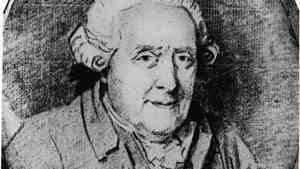 Wilhelm Friedemann Bach Source: Wikipedia |
|
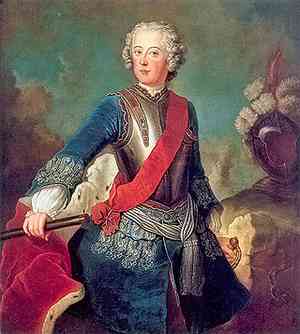 Frederick II Source: University of Houston |
Born
on 24 Jan 1712 in Berlin,
Frederick II
(Frederick the Great; not)
was a member of the House of Hohenzollern.
He became a runaway at age 18 because his father was
King of Prussia, Frederick William I. Attempting to flee to England in 1730
with a friend waiting in Potsdam, he was caught and both arrested. The main
problem is that both of them were officers. The court martial found his
friend, one Hans Hermann von Katte, guilty of desertion, sentencing him to
life. Frederick William, however, believed treason a more just charge and
had Frederick observe Katte's beheading. Pardoned, Frederick was stripped of
rank and sent to study statecraft and administration in Küstrin. By 1733
Franz Benda
was present at the court of the young Prince, the same year that he
reluctantly married Elizabeth Christina of Brunswick, feeling that he would
be a poor husband. Sometime after that he reentered the Prussian army as a
colonel and assumed command of a regiment in Ruppin, there maintaining his
retinue of musicians. Moving his court to Rheinsberg in 1736, his company of
seventeen musicians included Benda and
Johann Gottlieb Graun at
violin, Benda's brother, Johann, at viola, Christoph Schaffreth at
harpsichord and Carl Heinrich
Graun who became director of chamber music in 1735 and Kapellmeister
1740. Frederick's book, 'Anti-Machiavel', was published anonymously in
September of 1740, a few months after succeeding Frederick William as King
of Prussia at age 28.
Carl Philipp Emanuel Bach joined Frederick's court no later than 1740.
In latter 1740 Frederick turned aside from
Enlightenment [1,
2,
3,
4,
5]
arts and humanities to attend to his realm, the first on his agenda being
the consolidation of his scattered territories resulting in the Silesian
Wars against Habsburg Austria [1740-45:
1,
2;
1st war,
2nd war,
3rd war].
In the meantime
Johann Joachim Quantz
joined is musical retinue
in December of 1741, though Frederick had attempted to acquire him since
1728. Then it was the Seven
Years' War [1754/56-63: 1,
2,
3] aligned with
Great Britain against Austria, France, Sweden and Saxony,
also involving North America relevant to the French and Indian War [1754-63:
1,
2,
3,
4,
5].
Come the War of the Bavarian Succession [1778-79: *] against Austria. Frederick
is considered among the greatest tactical geniuses in military history. s
well, it
wasn't unusual for him to lead his troops into battle, six horses shot from
beneath him during his military career. He owned, however, a concentrated prejudice against Poles, making Frederick the not so Great
with them as he applied various pressures to make them wish to leave his
acquired Polish domains. He far preferred Jews
to stimulate trade in an
economy he much improved [*], while running a Protestant monarchy that retained
Jesuits for their academic skills.
Frederick himself was a Freemason [1,
2,
3,
4,
5,
6]. He held
Plato
and Marcus Aurelius
in high regard, and corresponded with Voltaire
[*].
Frederick spoke six languages and could read Latin, ancient Greek and
Hebrew. He is also known for his construction projects, including
buildings, canals and his rococo Sanssouci Palace [1,
2]
built 1745-47. "Sans souci" translates to "carefree" from French. (There is
a similarly named Sans-Souci Palace in Haiti having naught to do w Fred: *.) Frederick also established the first veterinary school in Germany. Yet,
amidst all the greatly condensed foregoing Frederick found time to become a
skilled transverse flute player. A transverse flute is simply the modern
flute, held horizontally, unlike the recorder. Frederick composed four
symphonies, four concertos, 121 sonatas (11 lost), ten arias (1746-53), and possibly three marches.
He had begun to study composition at age seven w church organist, Gottlieb
Hayne. Though counterpoint was among his examinations he would imitate the
late baroque-galant style of Quantz. Frederick
had received lessons twice per year from
Quantz since 1728 before
running off to England in 1730. Frederick's sonatas
were confusedly catalogued with those of
Quantz
until Philipp Spitta clarified the situation in 1889 w SpiF numbering.
Several works associated w Frederick remain in argument as to their actual
composers. Frederick didn't publish his compositions which are of difficulty
to date beyond a little help from manuscripts having been left upon
Frederick's death at what residences where they had been written. Sarah Macken cites Eugene Helm who has
Graun correcting a symphony by his student, Frederick, as
early as 1735, possibly his No. 1. Of Frederick's four concertos his No. 1 in G
Major is of an unidentified date, published posthumously by Breitkopf &
Hartel in 1889 [*;
audio]. Macken gives his 'Sinfonia in D Major' a date of 1743
[*;
audio], also
identifying two marches as of 1741 and 1756. One march generally credited to
Frederick that is contested [*] is 'Der Hohenfriedberger Marsch' usually dated
1745 due to Prussian victory against Austria and Saxony on 4 June that year at the Battle of
Hohenfriedberger during the 2nd Silesian War. There is apparently no
documentation of the march until 1795 per a
piano piece by an unknown hand and it didn't receive lyrics until 1845.
Johann Piefke employed the march in his 'Königgrätzer Marsch' of 1866. Written by
Frederick or not, Arthur Pryor credited the work to him for his 1906
recording of it released on Victor 4778. It saw issue on cylinder in 1907 as
recorded by the
Edison-Orchester
in Berlin. Come the 1923 version by the
Victor Military Band for release on Victor 77172. Included in the twenty-five
sonatas that Spitta has catalogued is Frederick's 'Flute Sonata in C Minor' SpiF 190
[*;
audio]. Remarkable Frederick died at Potsdam in an armchair in his study at his Sanssouci
Palace on 17 August 1786. References:
Encyclopedia;
Sarah Macken; Wikipedia:
1,
2.
Authorship: 1,
2,
3,
4;
military speeches;
poetic: 1,
2,
3,
4,
5.
Musical works:
1,
2.
Scores.
Editions.
Audio: 1,
2,
3.
Recordings of: discos: 1,
2,
3,
4;
'Friedrich II: Flotenknzerte & Sinfonien' w flute by Manfred Friedrich.
Radio discussion w Melvyn Bragg.
Further reading: Fischer & Fulker.
Biblio: 'Frederick the Great: the magnificent enigma' by Robert Asprey (Ticknor & Fields 1986);
'History of Frederick II of Prussia' by Thomas Carlyle (Chapman & Hall 1858)
*
(alt);
'Frederick the Great: King of Prussia' by David Fraser (Fromm International 2001)
*;
'Music at the Court of Frederick the Great' by Eugene Helm (U of Oklahoma Press 1960)
*;
'Frederick the Great: a historical profile' by Gerhard Ritter (U of California Press 1968)
*;
'Frederick the Great' by Schieder, Scott & Krause (Routledge 2016)
*;
'Frederick the Great on Kingcraft' by Sir James William Whittall (Longamans, Green and Company 1901)
*.
Other profiles: 1,
2,
3,
4,
5,
6,
7,
8,
9,
10.
FredericK II Ensemble Sans Souci Berlin Flute: Christoph Huntgeburth Da Camera magna Cembalo: Stanislav Heller Flute: Marianne Steffen Da Camera magna Cembalo: Stanislav Heller Flute: Marianne Steffen Flute Sonata 14 in E flat major Da Camera magna Cembalo: Stanislav Heller Flute: Marianne Steffen Mark Longo Pro Arte Orchester/Kurt Redel |
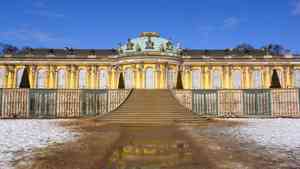 Sanssouci Rococo Palace |
| Born
on 28 June 1712 in the
city-state of Geneva,
Jean-Jacques Rousseau wasn't a major composer.
But he was a major Enlightenment
[1650-1800: 1,
2,
3,
4,
5] philosopher who was also a
music theorist. Rousseau's father was a watchmaker whose wife died nine days
after Rousseau's birth. At age 13 Rousseau worked for a notary, then an
engraver, then ran away to Savoy in 1728 (age 15) to find himself in the
care of Françoise-Louise de Warens, a paid Catholic proselytizer. Under
Warens Rousseau studied mathematics, music, philosophy and, at age twenty,
love with a woman fourteen years his senior. In 1742 he went to Paris to
present a system of numbered musical notation to the French Academy of
Sciences, which it rejected [*]. In 1743 Rousseau worked briefly as a secretary
for Comte de Montaigue, French ambassador to Venice, then returned to Paris
to finish his first of seven operas, 'Les Muses Galantes' by July 1745 [*],
premiering at the residence of Alexandre Le Riche de la Pouplinière [*] in September to
less than encouraging review by Rameau. In 1749 Rousseau began contributing articles to Diderot
[1,
2,
3,
4,
5,
6,
7,
8] and D'Alembert's
[1,
2,
3,
4,
5,
6]
'Encyclopédie' [1,
2,
3,
4, ,
5,
6,
7,
8]. Starting in 1751
[1st edition] the 'Encyclopédie' saw several
revisions over the years w the backing of Madame de Pompadour.
When Pope Clement XIII listed the project in the Index Librorum Prohibitorum
[1,
2]
in 1759 it continued being published in stealth until the project ceased in 1780.
The 'Encyclopédie' to which
Voltaire
also contributed articles was key to the chest of the Enlightenment with
which both Catholic and Protestant Churches found argument, for the
presentation of information in that dictionary saw faith confronted with
knowledge yet again, not as an absolute alternative, but stimulating reason versus
blind belief. The science, arts and manufacture of things that the
'Encyclopédie' presented lessened dependence on the Church(es) as final
authority and helped lay road for the Industrial Revolution
[IR: 1,
2,
3,
4] on the
Continent: access to information and the high literacy rate in the United
Kingdom was giving the island across the Channel a head start on the IR
already. In the meantime, back in 1752 soprano, Marie Fel, presented Rousseau's
'Salve Regina' to Louis XV at
Fontainebleau
on an unidentified date [audio].
Rousseau's 'Le Devin du Village' ('The Village Soothsayer') was performed
for Louis on 18 Oct 1752 [*,
audio]. Louis offered
Rousseau a lifetime pension in response, a position Rousseau declined. It
was 1754 that Rousseau penned his 'Discourse on Inequality' published the
next year [1,
2,
3]. By 1762 Rousseau had
made a name for himself in the writing of several
major works which yet brought small security to a man already fifty years
old. In 1762 Rousseau brought witness to 'Emile, or On Education' [1,
2], his
political 'On the Social Contract' [1,
2,
3,
4],
and his comedy, 'Narcissus'
[*], the
latter performed in Paris by his Majesty's Company of Comedians on the 18th
of December 1762. 'Emile' rejected the doctrines of original sin and
divine revelation, also proposing in so many words that it was religion that
wrought virtue, not Catholicism versus Protestantism. Such resulted in his
books being burned in Paris, as well as banned in both Catholic France and
Calvinist Geneva. Facing arrest, he fled to Neuchâtel, Switzerland, then Môtiers, they protected by the Prussian crown.
Both he and and his house were nevertheless
stoned on multiple occasions in 1765, urging him ultimately to the United
Kingdom and the hospitality of Scottish
philosopher, David Hume [1,
2,
3,
4,
5,
6].
He there wrote Books I-VI of his autobiographical
'Confessions'
posthumously published in '82. Rousseau was as aware of St. Augustine's
'Confessions' written circa 397-400 AD as he was that he was treading
untested literary waters in an endeavor to give an honest account of oneself. Employing the
public for priest, Rousseau added self-examination to other aspects of the
Enlightenment, the memoir henceforth entering into literature unlike before.
Howsoever, by 1767 Rousseau was experiencing paranoia.
Not trusting Hume, he returned to France that year with an assumed name, now
to write Books VII-XII of 'Confessions' posthumously published in 1789. In
1770 he was legally permitted to return to Paris, though not allowed to
publish. Rousseau's latter years were spent in social withdrawal with the
exception of
Christoph Willibald Gluck, whom he met in 1774. He died of hemorrhage in
Ermenonville on 2 July 1778 while taking a morning walk. Though Rousseau had been
far more concerned with political philosophy than music, in addition to
operas he composed more than fifty works, including two symphonies.
References: 1,
2,
3,
4.
Authorship: 1,
2,
3,
4,
5,
6.
Editions: 'Confessions" (1765-69):
Vol 1;
Vol 2; Vol 1-12:
1,
2;
'Considerations on the Government of Poland' (unpublished 1772)
*;
'Constitutional Project for Corsica' (draft 1765)
*;
'Discourse on Inequality' (pub 1755)
*;
'Discourse on Political Economy" (1755)
*;
'On Philosophy, Morality and Religion' ed by Christopher Kelly (2007)
*;
'On the Social Contract' (pub 1762 aka 'Principles of Political Right'):
1,
2,
3,
4.
Scores.
Audio.
Discos: 1,
2,
3,
4.
Biblio: 'Jean-Jacques Rousseau: Restless Genius' by
Leo Damrosch (Houghton Mifflin Harcourt 2005/07);
Helveticat;
'Concerning Jean-Jacques Rousseau, the Musician' by Julien Tiersot ('The Musical Quarterly').
See also: BnF;
Philosophy Bites; the
Rousseau Association.
Other profiles: 1,
2,
3,
4,
5,
6,
7.
Jean-Jacques Rousseau 1753 Gabriela Burgler Piano: Yoel Ahn Piano: Yoel Ahn |
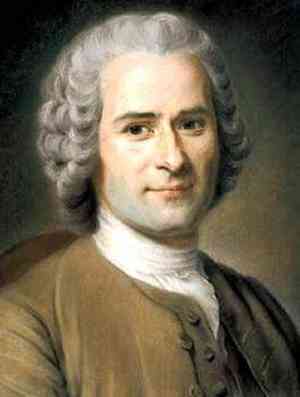 Jean-Jacques Rousseau Pastel: Maurice Quentin de La Tour Source: Canal Academie |
|
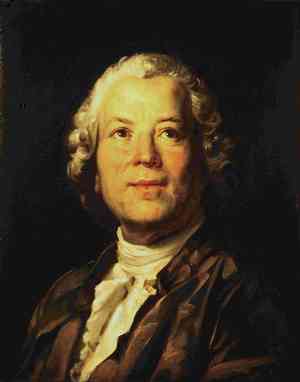 Christoph Gluck Painting: Joseph Duplessis Source: Sazburger Bachor |
Born in Erasbach (now
part of Berching, Bavaria) on 2 July 1714,
Christoph Willibald Gluck
was born to a forester and learned several instruments as a child. Like
Johann Stamitz, Gluck is of especial significance as an early bridge to
the classical period. His later major operatic rival in Paris would be
Niccolò Piccinni of Naples, the latter whose star flashed bright but not
for so long as Gluck's. In 1731 he enrolled into the University of Prague,
but he had no degree when he he popped up in Milan in 1737 to study under
Giovanni Sammartini. Commencing the Wq catalogue at Wq.1 is Gluck's first opera, 'Artaserse',
premiering on 26 December 1741 at the Teatro
Regio Ducal, libretto by
Metastasio. In 1745 Gluck became house composer at London's prestigious
King's Theatre. In 1747 he traveled to Dresden where he produced 'Le nozze
d'Ercole e d'Ebe' Wq.12 [1,
2],
partnering with the Pietro Mingotti troupe. He left for
Vienna with Mingotti the next year, then left Mingotti for the troupe of
Giovanni Locatelli in Prague in 1750, also composing 'Ezio' Wq.15 that year
[audio]. 1752
found him working in Naples before returning to Vienna in 1754. Wikipedia
begins its list of ballets by Gluck w 'Les Amours de Flore et Zéphire'
performed in Schönbrunn in 1759. In 1761
Gluck exchanged opera seria for opéra comique, producing his Italian 'Don Juan'
Wq.52 that
year w libretto by Ranieri de' Calzabigi and choreography by Gasparo
Angiolini [*. 'Orfeo ed Euridice'
Wq.30 w Italian libretto by Ranieri de' Calzabigi followed in Vienna in
October
'62, perhaps Gluck's most greatly hailed work [1,
2,
3;
libretto; 1913 cylinder recording by contralto,
Marie Delna]. Gluck found patronage
in Marie Antoinette, wife of King Louis XVI, in the early seventies. Come 'Iphigénie en Aulide'
Wq.40 on 19 April 1774 at the Paris Opera [1,
2].
On 2 August of '74 he presented another version of 'Orfeo ed Euridice' Wq.41 at the
second Salle du Palais-Royal (the first, built in 1741, destroyed by fire in '63 as would be the second, permanently, in 1781). It was another engagement
at the Paris Opera on 18 May 1779 for 'Iphigénie en Tauride' Wq. 46 [*] w libretto by Nicolas-François Guillar. Gluck's last completed dramatic
work was his opera, 'Echo et Narcisse' Wq.47 [*], performed on 28 May of '79 at the
Salle du Palais-Royal w libretto by Louis-Théodore de Tschudi. Gluck spent
the eighties w his wife in Vienna and Perchtoldsdorf until his death of stroke in Vienna on 15
Nov 1787. He had written instrumentals, songs and eight ballets, but his
significance as a composer was in his reformation of the opera, completing
49 of them. References encyclopedic: 1,
2,
3,
4;
musical: 1,
2.
Compositions: 1,
2,
3.
Ballets.
Operas.
Scores: 1,
2.
Editions: 1,
2,
3.
Audio: 1,
2,
3.
Discos: 1,
2,
3,
4,
5.
Further reading: 'Dance of the Blessed Spirits' and 'Dance of the Furies' in 'Orfeo
ed Euridice' by Rachel Beaumont;
Harriet Brower;
Paris Opera;
WikiTalk.
See also: BnF;
Gallica;
Musicalics.
Biblio: 'Christoph Willibald Gluck: A Guide to Research' by Patricia Howard (Routledge 2013);
Oxford.
Other profiles: 1,
2,
3,
4.
Wq numbering below is per Alfred Wotquenne in 1905. Christoph Willibald Gluck 1767 Wq 37 Teatro La Fenice in Milan Music director: Guillaume Tourniaire Stage director: Pier Luigi PizziAlceste: Carmela Remigio 1754 Wq 18 Orchestra of Schola Cantorum Basiliensis René Jacobs 1761 Wq 52 Mainzer Kammerorchester/Günter Kehr Doubtfully by Gluck [Wikipedia] Pro Musica Orchester Wien/Charles Adler Flute: Camillo Wanausek Album: 'Gluck, Pergolesi & Boccherini' 1762 Wq 30 Cesky Krumlov Castle/Czech Republic 2013 1762 Wq 30 Teatro La Fenice/Milan 2023 1770 Wq 39 Overture ORF Radio-Symphonieorchester/Lothar Zagrosek |
|
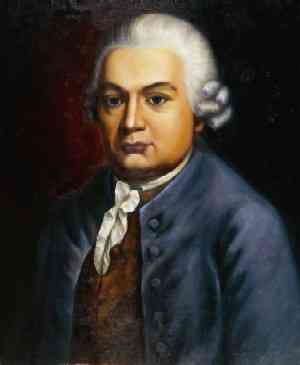 Carl Philipp Emanuel Bach Source: NAXOS |
Born
on 8 March 1714 in Weimar,
Carl
Philipp Emanuel Bach (aka "the other Bach") was son
to
Johann Sebastian Bach [Bach dynasty:
1,
2,
3]. Though he and his brothers had been taught music by his father, all
intending to become professional musicians, Bach studied law from 1731 to
1738, obtaining his degree. This was done to obtain better a position as a
musician, a little like joining the military as enlisted without rank versus as
an officer if you go to college first. Howsoever, Carl's
first compositions also date from 1731. Bach soon obtained employment in
Berlin from Crown Prince Frederick of Prussia [Frederick II], becoming a member of the
orchestra in 1740 upon Frederick becoming king. Bach was among the earliest
piano, versus harpsichord, virtuosos. The piano had been invented in 1700
in Florence by Bartolomeo Cristofori [1,
2,
3]. By 1740 his reputation as a clavier
(piano) player had already spread throughout Europe. He had also written
some thirty sonatas and such for harpsichord and clavichord by then. It was
1753 that his first volume of 'Versuch über die wahre Art das Clavier zu
spielen' ('Essay on the true way to play the keyboard') appeared in Berlin,
second volume following in 1762 [1,
2]. In 1768
Bach became director of music for Hamburg, also acquiring the patronage of
Princess Anna Amalia of Prussia (Frederick's sister). He now began concentrating more on sacred music such as cantatas. The next twenty years saw him produce some seventy
liturgical works along with 21 settings of the Passion until his death on 14 Dec
1788. Carl is noted for his
symphonies and keyboard pieces, especially sonatas and concertos, as well as
chamber and choral works. CPE shared similar stature as a composer with his father,
Johann Sebastian, and has
ever since. References: 1,
2,
3;
Wikipedia: 1,
2,
3.
Compositions: 1,
2,
3,
4,
5,
6;
Wq.
Manuscripts & scores: 1,
2,
3,
4;
downloads: 'Trio sonata in C minor' H 579 (1749 pub 1751);
'Fantasia e fuga in C minor' H 75.5 (1760?).
Editions: 1,
2,
3,
4;
'The Complete Works': 1,
2.
Sheet music.
Audio: 1,
2,
3,
4,
5,
6.
Recordings of: discos: 1,
2,
3,
4,
5;
'CPE Bach Edition' Brilliant Classics 94640 2013 (30 CD box set):
1,
2.
Usage in soundtracks: 1,
2.
Collections: Berlin Singakademie.
Furtrher reading: H. Bellermann;
Guy Dammann;
Tom Huizenga;
Eva Oertle.
Bibliographies: 1,
2.
See also: BnF;
Gallica;
Musicalics.
Other profiles: 1,
2,
3,
4,
5,
6;
Britannica: 1,
2;
Wikisource: 1,
2.
H numbering below is per the cataloguing system of Eugene Helm
as of 'Thematic Catalogue of the Works of Carl Philipp Emanuel Bach' (Yale U
Press New Haven 1989) [*]. Wq numbering
that is also seen with Carl Bach is per Alfred Wotquenne's earlier 'Thematisches
Verzeichnis der Werke von Carl Philipp Emanuel Bach' (Breitkopf & Härtel
Wiesbaden 1905/1972) [1,
2].
Convert H to Wq: 1,
2.
Carl Philipp Emanuel Bach Concerto for 2 Harpsichords in F major 1740 H 408 OSI Orchestra dela Svizzera Italiana Harpsichords: Ton Koopman/Tini Mathot 1755 H 445 Flute: James Galway 1786 H 564 Eckhart Duo Flute: Enrico Sartori Piano: Giuseppe Santucci Harpsichord Concerto in E minor 1745 H 418 Filmed in Hungary Győr University Orchestra Conducting: Gergely Ménesi Piano: András Kemenes 1775 H 663 Presto Orquesta de Cámara de Jerusalém Mendi Rodan 1757 H 654 Akademie für Alte Musik Berlin 1776 H 666 OSI Orchestra della Svizzera Italiana Ton Koopman
|
|
|
Born on 10 Sep 1714 in
Aversa, Italy,
Niccolò Jommelli
had a linen merchant for a father. In 1725 Jommelli was enrolled into the
Sant'Onofrio building of the Naples Conservatory of Music. Three years later
he was transferred to the Pietà dei Turchini building. Jommelli performed
his first opera in 1737 to considerable success, a buffa (comedy) called 'L'errore amorosa'.
He followed that later the next year w
'Odoardo'. His first seria, 'Ricimero re di Goti', was
performed in Rome on 16 January 1740 at the Teatro Argentina
[1,
2,
3].
He then quickly obtained the protection of Duke
Henry Benedict of York who, upon becoming a cardinal, appointed Jommelli to
the Vatican. He first performed 'Ezio' in Bologna on 29 April 1741, that
with libretto by
Metastasio. In 1745 he became
director of music at the Ospedale degli Incurabili in Venice. In 1747
Jommelli performed 'Didone abbandonata' at the Argentina Theatre in Rome,
that again with libretto by
Metastasio
[1;
audio].
Come his intermezzo a tre voci, 'Don Trastullo', in 1749 in Rome
[*; audio:
1,
2].
In 1753 he went north where the action was in Stuttgart, there becoming kapellmeister to
Duke Charles Eugene of Württemberg.
That was a welcome change of atmosphere for Jommelli,
a number of his operas to be performed at the private theatre of Charle's
Ludwigsburg Palace.
Jommelli returned to Naples in 1768, dying there on 25 August 1774. Though Jommelli's operas
had been highly popular
throughout his career in Italy, Venice and Germany,
his star didn't shine quite so bright as his immediate contemporaries
Christoph Gluck
and
Niccolò Piccinni.
References: 1,
2,
3,
4.
Compositions: 1,
2.
Scores: 1,
2.
Manuscripts: 1,
2.
Editions.
See also: BnF's
Gallica.
Audio: 1,
2,
3,
4.
Discos: 1,
2,
3.
Further reading: Bruno Forment;
Angela Romagnoli.
Bibliography: 'The Church Music of Davide Perez and Niccolò Jommelli' by Mauricio Dottori (DeArtes - UFPR 2008)
*; 'Niccolo Jommelli: The Last Years, 1769-1744' Marita McClymonds (UMI Research 1980).
Other profiles: 1,
2.
Per below, in 'Sinfonia in G major' Karl-Heinz Schickhaus plays a chromatic
dulcimer (hackbrett), developed in the 1930s from the hammered dulcimer,
which originated in the Middle East circa 1000 AD, soon finding its way to
Europe. Niccolò Jommelli Orchestra Giovanile Luigi Cherubini Riccardo Muti Orchestra Giovanile Luigi Cherubini Riccardo Muti Orchestra Giovanile Luigi Cherubini Riccardo Muti I Solisti Partenopei/Ivano Caiazza Piano: Antonella Cristiano Münchener Kammerorchester Hans Stadlmair Hackbrett: Karl-Heinz Schickhaus Piccola Orchestra Veneta Marco Bellussi Stuttgart Chamber Orchestra Frieder Bernius |
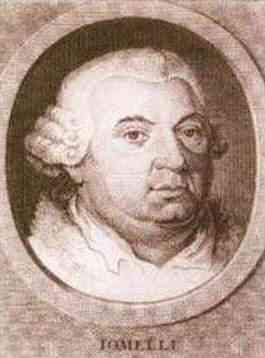 Niccolo Jommelli Source: Anacardiaceae |
|
| Born
on 21 March 1716 in Řepín, Bohemia,
Josef Seger
had been educated at a Jesuit gymnasium in Prague as a child. He took his
degree in philosophy from Charles University, meanwhile studying organ with
Bohuslav
Černohorský.
In 1741 Seger became organist at the Church of Our Lady before Týn
[*], adding a
similar position to his tasks in 1745 at the Church [1,
2,
3] of the Knights of the
Cross [1,
2]. He strayed not therefrom until his death in Prague on 22 April 1782.
The Bohemian region became among the more important during the Baroque and
Classical periods, core to the Holy Roman Empire where reign was determined
by a college of electors. Hotbed during the Thirty Years War (1618-48) in
the prior century, Seger's Bohemia was in preparation for Napoleon's
termination of the Holy Roman Empire not far to the future in 1806. A
century beyond that Bavaria would become part of Czechoslovakia (1918). As
for Seger who wrote both sacred and secular music, though he composed
several hundred works, none of which he published, he largely fell from relevance beyond his
contributions to Bohemian music as a teacher to numerous strong Czech
composers including
Karel Kopřiva,
Jan Koželuh,
Jan Křtitel Kuchař
and
Josef Mysliveček among others. Albeit
Seger's catalogue includes works for violin and voice like Masses, he
largely composed for organ such as toccatas, preludes, fugues and exercises
w figured bass. References: 1,
2.
Compositions: 1,
2,
3.
Scores: 1,
2,
3.
Audio: 1,
2.
Recordings of: discos: 1,
2;
'The Complete Organ Works' w Ales Barta organ (Bonton Music 1992).
HMR Project.
Josef Seger 1793 No 2 in G minor Organ: Allan Dieball 1793 No 6 in G major Organ: Allan Dieball 1793 No 7 in D major Organ: Allan Dieball Organ: Aleš Bárta Organ: Allan Dieball |
||
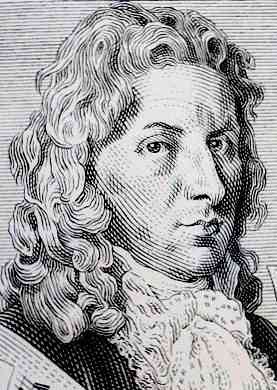 Johann Stamitz Source: Find a Grave |
Born
on 18 June 1717 in Deutschbrod, Bohemia,
Johann Stamitz
was a Czech composer who, despite his death at a young age,
became of major significance in the development of early classical
composition and orchestration, both as an innovator among his contemporaries
as founder of the Mannheim school [1,
2,
3,
4,
5],
and of long-lasting interest to such as
Joseph Haydn thirty years his younger and
WA
Mozart born the
year before Stamitz' passing in '57. Stamitz had studied at the University
of Prague in 1734/35 before quitting to play the violin, as he was virtuosic
with the instrument. His activities for the next several years are largely
unknown before he emerged at the Court of Mannheim circa 1741. It was
sometime between '41 and '46 that his Mannheim symphonies No. 1 through
No. 3 were
written. It isn't certain which was his first, nor if No. 1
wasn't actually composed by Antoine Mahaut.
It was 1 July 1744 that he married Maria Antonia Luneborn, two of five
children to arrive to die in infancy, two to become composers,
Carl Stamitz
and Anton Stamitz
[Stamitz family of composers].
Johann became formal director of his Mannheim school in 1750. His Op. 1,
'Six Grand Orchestra Trios', was likely authored and published sometime
during the fifties. 1754 found him performing in
Paris at a concert spirituel
(public concerts given in Paris since 1725). Returning to Mannheim in 1755,
he died two years later on 27 March 1757 only forty years of age. Stamitz left
behind 58 symphonies, 10 orchestral trios
and a number of concertos for various instruments.
References: 1,
2,
3.
Scores: 1,
2.
Editions: 1,
2,
3,
4.
Audio: 1,
2,
3.
Recordings of: MusicBrainz;
'Johann Stamitz Symphonies Vol. 1' by the New Zealand Chamber Orchestra w Donald Armstrong:
1,
2;
'Johann Stamitz Symphonies Vol. 2' (Op. 4) by the Northern Chamber Orchestra w Nicholas Ward
1,
2;
'Johann Stamitz Symphonies Vol. 3' (Op. 3) by the Musica Viva Chamber Orchestra
w Alexander Rudin
1,
2,
3.
Suggested reading: 'The Symphonies of Johann Stamitz' by Eugene Wolf (Scheltema & Holkema 1981): reviews:
Floyd Grave: *
(alt);
Neil Zaslaw.
Other profiles: 1,
2,
3. Johann Stamitz Op 1 Musica Aeterna Bratislava Clarinet Concerto in B flat major Academy of St. Martin In The Fields Iona Brown Clarinet: Sabine Meyer Cologne Chamber Orchestra Helmut Müller-Brühl Flute: Robert Aitken Alsfelder Vokalensemble Barockorchester Bremen Academy of St. Martin in the Fields Sir Neville Marriner Trumpet: Håkan Hardenberger |
|
| Born
on 21 November 1718 in Marpurgsdorf, Germany,
Friedrich Wilhelm Marpurg
wasn't the composer that others on this page were. But as a music theorist
he joins
Johann Mattheson as one of the earliest
music critics [rise and influence of music criticism: 1,
2,
3,
4].
Antonie at Classical Music Diary (CMD) has Marpurg arriving to a well-off family
with a mayor for a grandfather and probably private tutoring as a youth.
Come 1738 he was studying law at the University of Jena before transferring
to Martin Luther University of Halle-Wittenberg in 1739 where he would write
something about a high-ranking academic at Jena that found him getting sentenced
to prison by Frederick I
(Soldier King) of Prussia, father of
Frederick II (aka the
Great). Making
flight to Normandy, he there studied the music of
Jean-Philippe Rameau and
François Couperin [CMD].
Frederick II himself had run away from his father
in 1738. His return and subsequent reign in 1740 upon the death of Frederick
I spelled Marpurg's ability to return to Prussia. In either 1744 or 1746
he became secretary to Prussian general, Friedrich Rudolf von Rothenburg, in
Paris where he is said to have met
Rameau as well as Rond d'Alembert and Voltaire. Upon returning to Berlin
Marpurg pursued his education, presumably yet in law, to completion in 1748.
The first edition of Marpurg's weekly
critical periodical appeared in 1749: 'Der Critische Musicus an der Spree'
[*].
As Marpurg's career is heavily literary it is apt here to touch a little on the
history of publishing.
Please see Note 1 below. Further works in prose followed in the early
fifties until a volume of compositions in 1756 titled 'Neue Lieder zum
Singen beim Klavier' [*]. Marpurg became employed with the Royal Prussian Lotteries in
1760, becoming director in 1763. [Lottery history is an interesting subject
but a little off topic. See Note 2 below.] Numerous volumes of both music
criticism and compositions followed throughout the sixties and into the
seventies such that the esteem with which Marpurg's books were held led to
some long-enduring confusion upon his 1776 'Versuch über die musikalische Temperatur'
[1,
2,
3]
in which he confused
Johann Sebastian Bach's
'Das Wohltemperirte Clavier' with equal temperament.
Later examination
found Bach's well-temperament to be distinct from equal, notably per 'An
Elementary Treatise on Musical Intervals and Temperament' by Robert Holford
Bosanque in 1876 and 'Zur musikalischen Temperatur' by H. Kelletat in 1960.
In 1786 Marpurg published his musical almanac, 'Legende einiger
Musikheiligen' [1,
2,
3,
4,
5]. His last known authorship was his 1795 treatise titled 'Abhandlung über die
Orgel und Material zu einer Geschichte der Orgel' included in Ernst Ludwig
Gerber's 'Neues historisch-biographisches lexikon der Tonku̇nstler' of 1812
[*]. Marpurg died
in Berlin on 22 May 1795.
References: 1,
2,
CMD.
Works: 1,
2.
Scores.
Manuscripts: 1,
2,
3,
4.
Editions.
Recordings of: 'Pieces de Clavecin' w harpsichord by Yves-G. Préfontaine:
1,
2.
Further reading: Frank Gellerich;
Georg Predota.
See also BnF.
Other profiles: 1,
2,
3. Friedrich Wilhelm Marpurg C 1790 Organ: Kees Rosenhart Pub 1753 Organ: Rolf Uusväli Organ: Kees Rosenhart C 1790 Chorale prelude in A minor Organ: Rolf Uusväli ^ Note 1 in relevance to the history of publishing. Gazettes had been written or carved since ancient times by Chinese and Romans, placed in public areas for reading. Books got copied by hand until Johannes Gutenberg's printing press circa 1440 which opened the gates to mass circulation, newspapers [1, 2, 3] and other periodicals [early British and American: 1, 2, 3, 4, 5, 6]. As for publishing scores, plainchant saw print as early as Ulrich Han's 'Missale Romanum' of 1476 [1, 2]. The first to print more difficult polyphony, however, was also the first major publisher of sheet music, Ottaviano Petrucci of Venice [1, 2], starting w his 'Harmonice Musices Odhecaton' of 1501 [1, 2]. Petrucci's triple plate method would be improved circa 1520 in England by John Rastell's single plate pass, followed in France in 1528 by major publisher, Pierre Attaingnant's, 'Chansons nouvelles en musique à quatre parties'. ^ Note 2 in relevance to the Prussian Lottery: Lotteries had been in use in China since before the birth of Christ. They were one way the Great Wall of China was financed. Romans funded projects with lotteries as well. Lotteries disappeared during the Dark Ages to reemerge in the 15th century in towns of the Low Countries, then Milan in 1499. The first record of a town lottery in Netherlands, for walls and fortifications, wasn't a record of the first lottery held, but documents 4,304 tickets sold, for a prize of 1,737 florins, about $170,000 today. Lotteries were also held to feed the poor. Most are familiar with the legend of Nathan Mayer Rothschild making a fortune w a pigeon per the Battle of Waterloo in 1815, the truth of that story yet in debate [1, 2, 3, 4]. However, during the Age of Enlightenment (Age of Reason), stretching broadly from the humanism of the Renaissance to the Napoleonic defeat of the Holy Roman Empire in 1806, the philosopher, Voltaire, did actually help finance his writing career by outmaneuvering the French Lottery [1, 2, 3, 4, 5, 6, 7, 8] in 1729. References for lotteries: 1, 2, 3, 4, 5, 6; United States: 1, 2, 3, 4. The Age of Reason is also more narrowly dated from Isaac Newton's 'Principia Mathematica' in 1687, or the death of Louis XIV (Baroque Sun King) in 1715 commencing the reign of Louis XV (the Beloved), to the outbreak of the French Revolution in 1789,
|
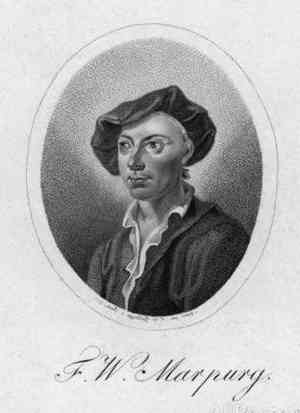 Friedrich Wilhelm Marpurg Source: Opera Plus |
|
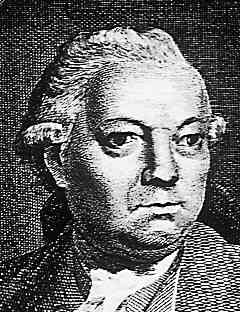 Jiri Antonin Benda Source: Leporelo |
Born
on 30 June 1722 in
Bohemia, violinist Jiri
Antonin Benda
(Georg Anton Benda) was younger brother to
Franz Benda
and Johann Georg Benda, older brother to
Joseph Benda, sons of
the weaver Jan Jiri Benda [1,
2,
3].
His sister, Anna Franziska, was an operatic soprano. He entered the Jesuit gymnasium in Gitschin in 1735. The year before
graduating (1742) he was made second violinist at the chapel of
Frederick II [Frederick the Great of
Prussia:
Wikipedia] in Berlin. Upon leaving the gymnasium Benda began
composing in Potsdam with his brother for a brief a time. His next
employment was in 1749 as Kapellmeister to the Duke of Gotha,
Frederick III, eldest son of
Frederick II. The Duke provided him
with the funds to study in Italy for a couple of years in 1764. Benda
retired from the court in 1778 to travel about Europe, such as Hamburg and
Vienna, and eventually settled in Köstritz where he died on 6 Nov 1795. Among
Benda's more important contributions to the classical period was the
melodrama. The melodrama was an interesting operatic development in which
thrill was of more weight than characterization, like action films w simple plots and stereotypical roles
versus dramas, and usually spoken
rather than sung. The Singspiel was closely related, a kind of dialogic
opera. The first full melodrama was written in 1762 by the Coignet/Rousseau
team, though not performed until 1770 ('Pygmalion'). Benda saw therein a
potential to exploit, as would
Mozart.
References for Benda: 1,
2,
3,
4,
5.
Scores.
Editions.
Audio: 1,
2,
3,
4.
Discos: 1,
2,
3,
4.
HMR Project.
Jirí Antonín Benda 1775 Melodrama Libretto: Johann Brandes Kammersolisten Minsk Dmitri Subow Concerto for harpsichord in G minor Talichův komorní orchestr Jan Talich Cembalo: Zuzana Růžičková 1779 Melodrama Libretto: Friedrich Gotter Prague Chamber Orchestra Christian Benda 1776 Singspiel La stagione Frankfurt Michael Schneider Julie: Heidrun Kordes Romeo: Scott Weir Prague Chamber Orchestra Christian Benda Prague Chamber Orchestra Christian Benda Prague Chamber Orchestra Christian Benda |
|
| Born in Köthen
of present-day Germany, on 22 Dec 1723,
Carl Friedrich Abel
was an early classical composer who specialized in cello and viola de gamba
as a performer. His father was composer, Christian Ferdinand Abel
[*]. He received
additional instruction from
Johann Sebastian Bach
at Thomasschule in Leipzig, among the oldest schools in Europe, founded in
1212. In 1743 Abel joined
Hasse's court orchestra where he
remained the next fifteen years. In 1759 he crossed the Channel where he
published his Op. 1 circa 1760 consisting of six symphonies w 'Symphony in
B-flat major' as WK 1.
(WK numbers are Walter
Knape as of 1971.) In 1762 Abel
began his collaborations with
Johann Christian Bach
in 1762 in London. Abel and Bach gave concerts together until the latter's
death in 1782. Abel became a chamber musician for
Queen Charlotte in 1764.
Upon Bach's death in '82 Abel traveled in Germany and France for the next
three years. He finished out his life as a chief member of the Hanover
Square Rooms (Queen's Concert Rooms). Giving his last concert on 21 May of
'87, he died the next month on 20 June 1787. Abel's catalogue hasn't always
been in order with such as his 'Symphony in E flat' once ascribed to Mozart
as 'Symphony No. 3' K 18. Twenty-eight of his works went missing until
discovered in 2017 by Sonia Wronkowska in what are called the
Maltzan Manuscripts
[see also the Maltzan-Sammlung].
A sonata by
JC Bach was also found w those manuscripts.
References: 1,
2,
3,
4,
5.
Works: 1,
2,
3.
Scores: 1,
2.
Publications.
Editions: 1,
2.
Audio: *.
Recordings of: discos: 1,
2,
3,
4,
5;
'Symphonies Op. 1 & Op. 4' consisting of 12 symphonies by the Kölner Akademie w Michael Alexander Willens
*.
HMR Project.
Carl Friedrich Abel 1767 WK 15 Op 7:3 La Stagione Frankfurt/Michael Schneider 1785 Op 17:3 The Hanover Band/Anthony Halstead 1767 WK 18 Op 7:6 La Stagione Frankfurt/Michael Schneider |
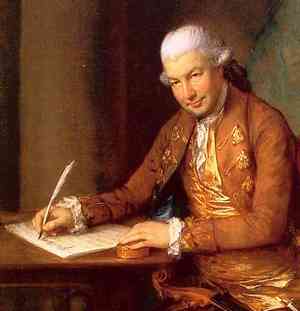 Carl Friedrich Abel 1777 Painting: Thomas Gainsborough Source: Wikimedia Commons |
|
|
Born on 25 Feb 1727 in
Paris,
Armand-Louis Couperin
was one of the Couperin musical dynasty, his cousin,
François Couperin,
among the most notable. Louis' father was a church composer and organist.
Upon his father's death in 1748, Couperin inherited his position at Saint
Gervais. He held positions at several churches, as well as the Royal Chapel
of Louis XV, before his death in a traffic accident on 2 Feb 1789. His library
contained 885 books, indicating he was financially comfortable. What little
music by Couperin that survives (he published little) is largely keyboard
pieces. He never wrote for theatre.
References: 1,
2,
3,
4.
Works: 1,
2,
3.
Scores.
Editions: 1,
2,
3; 'Complete Keyboard Works' by
Martin Pearlman.
Audio: 1,
2.
Discos: 1,
2,
3. Armand-Louis Couperin L'Affligee 1751 Harpsichord: Jennifer Paul La Chéron 1751 Harpsichord: Skip Sempé Les Quatre Nations 1751 Cembalista: Falerno Ducande Les Tendre Sentimens 1751 Harpsichord: Jennifer Paul Harpsichord: Onofrio Della Rosa |
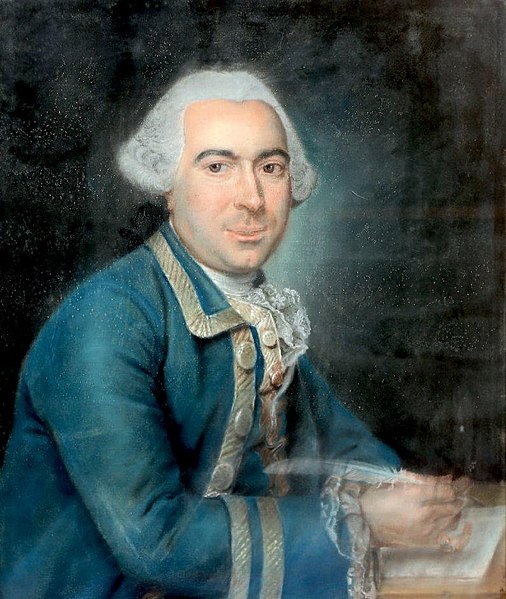 Armand-Louis Couperin Charles-Nicolas Noël 1766 Source: Wikipedia |
|
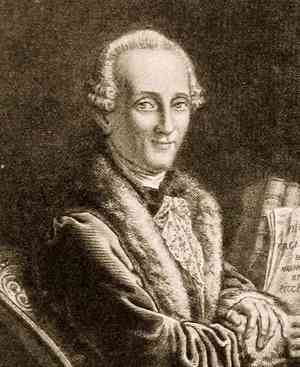 Niccolo Piccinni Source: Foggia Zon |
Born in Bari in
southern Italy on 16 Jan 1728,
Niccolò Piccinni
was educated at the Naples Conservatory of Music, Sant'Onofrio, his father a
musician of whom it is said he didn't want his son to make the same mistake.
Highly successful at opera, Piccinni produced his first, 'Le donne dispettose',
in 1755. Sixteen of the
librettos to which he set music were
Metastasio's. The first, 'Zenobia'
[1,
2], premiered on 18 Dec 1756 in Naples at the Teatro San
Carlo. 'Zenobia' had first been performed in Wien (Vienna) back in 1737 w music by
Giovanni Battista Bononcini. It was 1760 when Piccinni's 'La buona Figliuola' ('La Cecchina') ignited not
only Naples, but all of Europe [*;
libretto].
The libretto for that was by Carlo Goldoni
after Samuel Richardson. Piccinni
had and would set music to seventeen librettos to which Goldoni had
contributed. Spending the sixties continuing to thrive, in 1770 his music to
Metastasio's
'Catone in Utica' was taken to Mannheim, Germany, by tenor, Anton Raff,
where the score was somewhat altered for performance
[1,
2,
3].
By 1773 Piccinni had written 50 operas, performing thirty of them in
Rome. His setting to
Metastasio's
'Didon Abbandonata' had premiered on 8 January 1770 at the Teatro Argentina
[1,
2].
That had been
Metastasio's
first libretto put to music by Domenico Sarro back in 1724. In 1776 Piccinni found patronage
in Marie Antoinette who brought him to Paris to compose operas at the Academie Royale de Musique. One could say Piccinni took the "Neapolitan
school" to France, but what he really took was a Piccinni way of composing
opera versus that of his major rival at the time,
Christoph Willibald Gluck.
His 'Roland' [1,
2] premiered at the Academie Royale on 27 January 1778 w libretto
by Jean-François Marmontel [1,
2] after Philippe Quinault and Ludovico Ariosto.
Piccinni worked w Marmontel on five operas including the notable 'Didon'
[1,
2,
3] performed at the private theatre at Fontainebleau on 16 October 1783, that
taken after
Metastasio's 'Didone
abbandonata' of 1724. Piccinni became a professor at the Royal School of Music in 1784.
Piccinni last worked w Marmontel per 'Penelope' premiering on 2 November
1785 at Fontainebleau [*;
libretto].
A second version was performed in Paris on 16 October 1787, that Piccinni's
last before the
outbreak of the French Revolution [1,
2,
3,
4,
5,
6,
7] in 1789 and his return to Naples, there employed by
Ferdinand IV. Which was fine until Piccinni's daughter married a French democrat.
He was then placed under house arrest for four years, suspected of being a
revolutionary. Piccinni completed his life traveling between Naples, Rome
and Venice. Wikipedia traces his last opera, 'Il servo padrone, ossia, L'amor
perfetto'), to Venice, premiering at the Teatro San Samuele on 17 Jan 1794 w
libretto by Caterino Mazzolà [1,
2]. Returning to Paris in 1798,
Piccinni died two years later in Passy on 7
May 1800. Wikipedia has him composing 115 operas during his career. Though
Piccinni made quite a splash in his time it was a brief fame, he largely
forgotten since then. References: 1,
2,
3,
4,
5,
6.
Operas.
Scores: 1,
2.
Editions: 1,
2.
Audio: 1,
2,
3.
Recordings of: discos: 1,
2,
3;
'Roland' by the Bratislava Chamber Choir and the Italian International Orchestra w David Golub
*.
Other profiles: 1,
2,
3.
Niccolò Piccinni La buona figliuola, ossia La Cecchina 1760 Orchestra della Rai di Napoli Franco Caracciolo 1770 Overture Filharmonia Krakowska Nicola Simoni First Performance 1778 Paris Coro de Cámara Bratislava Orchestra Internazionale d'Italia David Golub |
| The Classical period
is generally given as 1730 to 1820. Popped from the oven in Mannheim in
1731 for cooling off w baptismal waters on 28 Dec,
Christian Cannabich is firmly
planted in the soil of the classical period and
helped make a steamroller (conveniently apt:
1,
2) of the Mannheim school
[1,
2,
3,
4,
5],
the latter an important bridge to the classical w its large symphonic
orchestra. Like the origins of rock n roll to which one can pin a lot of
early R&B artists over a range of several years without naming any singular
"father" of rock, so is Cannabich joined to a bunch consisting of such as
Johann Christoph Friedrich Bach,
Johann Christian Bach,
Joseph Haydn and
Leopold Hofmann as a
so-called patriarchy of the classical. Cannabich's father was a flute and oboe
player to the Mannheim court. Cannabich became a scholar violinist in the
Mannheim court orchestra in 1744 as he studied under
Johann Stamitz, then a full member two years later. In 1750 he visited
Rome on the Palatinate's (Duke Charles Theodore of Sulzbach) tab to study
beneath Niccolò Jommelli.
He studied under
Giovanni Battista Sammartini
in Milan in 1756. By 1757 he was ready to assume
Stamitz' position as first violinist to the court of Mannheim. His first
of not a few trips to Paris occurred in 1764. In 1774 Cannabich became
director of the Mannheim court orchestra, required to compose for ballet. He
died on 20 Jan 1798. Though Cannabich and
Mozart led
separate careers they associated
on numerous occasions. Mozart, a generation younger than Cannabich and whose
name defines classical, had instructed Cannabich's daughter, Rose, at piano
and dedicated his 'Piano Sonata 7 in C Major' to her. Cannabich left behind forty ballets, thirty sonatas
and 75 symphonies amidst much else.
References: 1,
2,
3,
4,
5.
Works: 1,
2,
3,
4,
5,
6.
Scores: 1,
2.
Editions: 1,
2,
3.
Audio: 1,
2,
3.
Recordings of: discos: 1,
2,
3;
'Die Mannheimer Schule' by the Camerata Bern directed by Thomas Furi
*.
Other profiles: 1,
2.
Christian Cannabich Symphony No 57 in E flat major Allegro London Mozart Players/Matthias Bamert Neue Hoffkapelle München Conductor: Christoph Hammer |
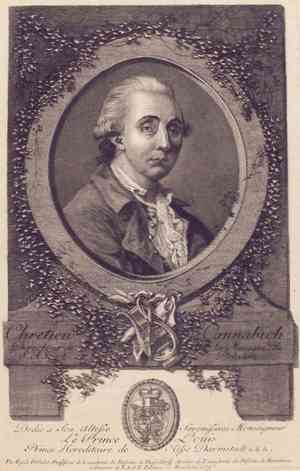 Christian Cannabich Engraving: Egid Verhelst 1779 Source: Wikimedia Commons |
|
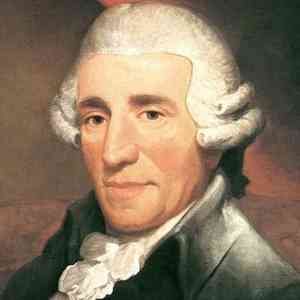 Joseph Haydn Source: Regio Chor |
In a failed attempt
to make this webpage search friendly we need limit the number of works we
list per composer. Which isn't to very represent any of them. But that is
especially true of
Franz
Joseph Haydn,
older brother to
Johann Michael Haydn.
Joseph was one of the musical supernovas of all time, why Classical is
called Classical. Haydn was born on 31 March 1732 in Rohrau, Austria (on the
Hungarian border at the time). His father was the village mayor, his mother
a cook for Count Harrach. Recognizing Hadyn's gift, his parents sent him at
perhaps age six to study music beneath a choirmaster in Hamburg named Johann
Matthias Frankh. In 1740 he went to Vienna to work as a chorister at St.
Stephen's. A small note is here due to Vienna, Austria, a little neglected
up to now for all its importance in European affairs. Though not Italy,
Vienna had been a major cultural center during the Renaissance and Baroque
periods. Austria, however, had been the Habsburg Holy Roman Empire's first
line of defense against the threat of the Turkish Ottoman Empire in the Hungarian region
[*], and
the bubonic plague of 1679 had claimed a third of its population. Upon final
riddance of the Turkish menace at the Battle of Vienna
[1,
2,
3,
4] on 12 September
1683 Vienna was able to prepare for its inclusion on the musical map of Europe in
no small way via figures such as Haydn,
Mozart and
Beethoven. Vienna was now
to become and remain among Europe's grandest venues of art, architecture and
music [1,
2,
3,
4] which this history will visit often.
Such was less than foremost in Haydn's thoughts, however, when in 1749 he was caned and dismissed for the prank of snipping
off another chorister's pigtail. He then freelanced, working as a teacher
and serenading on the streets. In 1752 he became valet to
Niccolo Porpora [mentioning such in his autobiographical sketch of 1776:
1,
2,
3]. Thus far Haydn had been taught next to nothing but
hunger by Frankh and at St. Stephen's. Nigh all he knew about composing had
been from independent study of such as
Johann Joseph Fux and
Carl Philipp Emanuel Bach. Finally getting some traction, Haydn produced
his first opera, 'Der krumme Teufel' ('The Limping Devil'), in 1753, only to
be shut down for offensive language [1,
2]. Meanwhile compositions he'd written and
given away to others were being published and sold by them. Poor Haydn was
yet just too simple for a human world. He had worked for nobility
before, briefly in 1752, and as a freelancer at the court in Vienna from '54
to '56. But in 1757 he became Kapellmeister to Count Morzin of Austria and
things began to swing enough for him to write his first symphonies before
marrying one Maria Keller on 26 November 1760.
Unfortunately the Count was experiencing twists in fortune necessitating the
dismantling of his musical establishment in 1761. Haydn then became
Vice-Kapellmeister for Prince Paul II Anton, and full Kapellmeister in 1766.
Anton had been succeeded by Nikolaus in 1762, but he was still of the House
of Esterházy, a dynasty of great wealth with several palaces such as the
Eszterháza, the "Hungarian
Versailles" in modern day Austria where
Haydn worked. Haydn premiered his second opera, 'Acide' [audio], on 11 Jan
1763 at a festa teatrale (theatre party) the day after the wedding of
Countess Maria Theresia Erdödy to Count Anton Esterházy, eldest son of
Nikolaus. Now in element not wholly despicable, Haydn wrote his third opera
('La marchesa nespola') before beginning to compose
for
baryton
(similar to the viol) circa 1765, as Nikolaus then acquired and began to
play one. Haydn produced some 200 pieces for that
instrument in the next ten years. By Haydn's time the Age of Enlightenment,
which some begin with Descartes' 'Discourse on Method' in 1637, was nearing
the end of its era w the approach of the French Revolution in 1789. As
things reasonable go, there developed a Counter-Enlightenment in the form of Sturm
und Drang [Storm and Stress: 1,
2,
3], a proto-Romantic movement in Germany
stretching from the early seventies into the early nineties in which
objective Enlightenment rationality had yet to account for the reality of
subjective individuality. Passion was everywhere in the climate during the
latter 18th century versus polite society where perfection's fine and
refined again ways, including the galant, were doomed to short days: the American Revolution
(1775-83) across the Atlantic a conspicuous example. As Haydn identified w
the Sturm und Drang movement along w authors like
FM Klinger,
JW Goethe,
Friedrich Schiller and
JG Herder,
his music during the seventies was expressive of such. One early example of
emotional deployment more to the masculine than delicate galant occurs in his 'Sonata in C minor' Hob. 16:20 for
keyboard [1,
2,
3,
4,
5;
audio: 1,
2].
Come his 'Trauer' ('Mourning') Symphony in E minor' No. 44 in 1772
[1,
2,
3;
audio: 1,
2,
3,
4].
His next was his 'Farewell' 'Symphony in F-sharp minor' No. 45 premiering
for Nikolaus in Nov of 1772 w an especial show of taste incorporated into
its performance, requesting leave for his musicians from Eszterháza that
season by each one blowing out his candle rack and walking away until there
were only a couple left to play [1,
2,
3,
4,
5,
6,
7;
audio].
'Farewell' saw publishing in '75. Haydn's Op. 20 of 1772 consisted of his
six 'Sun' quartets [1,
2]
firmly expressive of classical composing decisively not galant, away
from which Hadyn steered. The finales of three of those quartets, however,
employ the fugue, falling back to baroque counterpoint, though now invested
w Sturm und Drang, in emphasis of Haydn's distance away from lightweight
rococo. Of those six string quartets the three with fugal finales are No. 2
in C major, No. 5 in F minor [*;
audio: 1,
2]
and No. 6 in A major. Those saw
publishing in Paris in '74 by Chevardière, again in '79. Come more Sturm und Drang w his 'Keyboard
Sonata in D major' No. 33 in 1773, published in 1783
[1,
2]. Once Nikolaus ceased playing the baryton
Haydn was better able to concentrate on other work. Another change in 1779
again defined the sort of music Haydn wrote, he now allowed to compose and
publish music as his own property rather than that of the House of Esterházy. He now focused on symphonies
and would compose his six 'Russian' string quartets, Op. 33, in 1781
[1,
2;
audio], one
of which was 'String Quartet in E-flat' Op. 33 No. 2 known as 'The Joke'
[*;
audio]. Up to that time
one of Europe's major composers was nowhere to be seen except at
an exclusive Esterházy palace. Now Haydn could write on commission for clients
throughout Europe. Haydn's last opera for the House of Esterházy, 'Armida',
premiered on 26 Feb 1784 at the Eszterháza theatre [1,
2,
3]. That same year Haydn met and played quartets with
Mozart, their
association one of mutual high esteem. Haydn's first version of his
orchestral 'The Seven
Last Words of Christ' was commissioned in 1786 for the Oratorio de la Santa Cueva [*] in Cadiz, published in Paris in 1787 [1,
2]
where it was performed again before taken to Rome. Nikolaus died in 1790, leaving Haydn
a sweet pension of 1000 florins a year. But his son, Anton, was faced with
need to economize. He dismissed the majority of his musicians and reduced
Haydn's pay to 400 florins a year, yet fairly good remuneration for a
composer at the time, equivalent to about $65,000 today. Yet in the bargain
was Anton's liberation of Haydn to travel and work with other than Esterházy
musicians. On his first trip to London in 1790 Haydn met
Beethoven. Their relationship was a bit more complex than his friendship
with
Mozart. Though
Haydn tutored
Beethoven later that
year in Vienna, the latter later stated he "learned nothing" from Haydn.
Howsoever, Beethoven
later
placed Haydn with
Johann Sebastian Bach
and
Mozart in
eminence. Haydn sailed to England again in 1791. As his
published works had preceded him he was already very popular there. After visiting
Mozart briefly in Vienna on New Year's Day, 1791, Haydn headed for English soil and
there became a rock star both as a composer and clavier
performer. His 'Symphony in G major' No. 94 was performed in London on 23
March 1792 [1,
2,
3,
4]. That was Haydn's 'Surprise' symphony employing trumpets and
kettle drum [timpani], the latter which he had changing pitch during the
course of the work [*].
Haydn's last opera, 'L'Anima del Filosofo' ('The Soul of the Philosopher'
aka 'Orfeo ed Euridice'), was supposed to have been staged at the King's
Theatre in '92, but wasn't. Nor was it ever performed during his lifetime.
Haydn's 'Symphony in G major' No. 100 is known as his 'Military' symphony
again w trumpet and timpani effects [1,
2,
3;
audio: 1,
2].
Performed in '93 or '94, it saw publishing in 1799 by Johann André. Haydn's
'The Clock', 'Symphony in D major' No. 101, was performed on 3 March of 1794
[1,
2,
3,
4,
5,
6;
audio]. Haydn's
'Drumroll' 'Symphony in E-flat major' No. 103 premiered at the King's
Theatre on 2 March 1795, also published by André in 1799
[1,
2,
3,
4;
audio]. 'Drumroll' is
considered Haydn's symphony of symphonies along with 'Symphony in B-flat
major' No. 102 of '94 and 'Symphony in D major' No. 104 of '95. Together w
his string quartets those are cited as the creme de la creme of Haydn's
classical composing. In 1795 Haydn left London permanently for Vienna. Prince Anton
had meanwhile died and his son, Nikolaus II, wanted music. Haydn then
divided his time between the House of Esterházy in the summers and his own
home in Vienna the rest of the year, composing for public performances.
Haydn's oratorio, 'The Creation', premiered on 29 April 1798 at the palace
of Prince Schwarzenberg [1,
2].
'The Seasons', another oratorio, followed on 24 April 1801 [1,
2;
audio]. Haydn's last major work was his sixth
and last mass since 1796 for Princess Maria Hermenegild, wife of Nikolaus II,
that
'Harmoniemesse' in 1802 [1,
2;
audio]. In 1803 he began to become too ill to work, his last public
appearance a charity performance of 'The Seven Last Words' in December that
year. Though Haydn was unable to work during his last years he was retained
as Kapellmeister by the Esterházy family until his death on 31 May 1809.
He had sustained an attack of smallpox as a child. But what plagued him in
his last years
was polypus so severe as to prevent him from composing. Perhaps on those
occasions he pulled out his rosary, he a devout Catholic.
References: HOASM (Here
as of a Sunday Morning);
Klassika (extensive);
Theodora; Wikipedia:
1,
2,
3,
Wikisource.
Compositions: 1,
2,
3,
4,
5,
6,
7;
concertos: 1,
2,
3;
Masses: 1,
2,
3;
operas: 1,
2,
3,
4,
5; piano
solos *;
piano trios: 1,
2;
string quartets: 1,
2;
symphonies: 1,
2,
3.
Scores: 1,
2,
3,
4,
5,
6,
7,
8.
Editions: 1,
2,
3,
4,
5.
Audio: 1,
2,
3,
4,
5 (w bio),
6,
7;
Edison cylinders *;
MIDI files: *
(alt);
symphonies.
Recordings of: discos: 1,
2,
3,
4;
'Acide' w Bernard Richter (tenor) as Acide & Raffaela Milanesi (soprano) as Galatea and the Haydn Sinfonietta Wien on period instruments directed by Manfred Huss *;
'Creation' by Handel and the Haydn Society w Harry Christophers *;
'Haydn: String Quartets Op.33 'Russian'' by the Borodin Quartet *.
Usage of Haydn in soundtracks.
Further reading: Haydn and JS Bach,
Beethoven,
WA Mozart,
the timpani.
Biblio: 1,
2;
'Biographische Nachrichten von Joseph Haydn' by Albert Christoph Dies (1810 inaccuracies found since then):
1,
2;
'The Cambridge Companion to Haydn' by Caryl Clark (Cambridge U Press 2005)
*; 'Haydn' by David Wyn Jones (Routledge 2017)
*;
'The Classical Style: Haydn, Mozart, Beethoven' by Charles Rosen (1997)
*; 'Haydn' by James Cuthbert Hadden (1902)
*;
'Haydn: His Life and Music' by H. C. Robbins Landon & David Wyn Jones (1988)
*;
'Haydn Piano Sonatas' by Yaokun Yang *;
'The Life and Times of Franz Joseph Haydn' by Susan Zannos (Mitchell Lane
2019) *;
'The New Grove Haydn' by Jens Peter Larsen (1983). See also:
The Cambridge Haydn Encyclopeida ed by Caryl Clark and Sarah Day-O'Connell
*;
The Haydn Festival (1989-2019) *;
The Haydn Institute *; Wikimedia Commons
*.
Other profiles: Catalan *;
Deutsch: 1,
2;
Dutch: *;
English: 1,
2,
3,
4,
5,
6,
7,
8,
9,
10,
11,
12;
Finnish: 1,
2;
French: 1,
2;
Portuguese: *. Catalogue
numbers below are from the Hoboken-Verzeichnis published in three volumes by
Anthony van Hoboken between 1957 and 1978
[1,
2]. Joseph Haydn Hob 11:87 Esterházy Ensemble Hob 11:91 Esterházy Ensemble Hob 2:17 Haydn Sinfonietta Wien Manfred Huss Hob 7d:1 Orchestre de Chambre National de Toulouse Alain Moglia Horn: André Cazalet 1771 Hob 16:20 Piano: Andras Schiff Keyboard Sonata in E-flat major 1789-90 Hob 16:49 Piano: Alfred Brendel 1798 Hob 22:11 Gloria Det Norske Blåseensemble Solistkor Oslo Grete Pedersen 1798 Hob 22:11 Kyrie Det Norske Blåseensemble Solistkor Oslo Grete Pedersen 1790 Hob 15:14 Cello: Philipp Bosbach Piano: Harald Hoeren Violin: Susanne von Bausznern 'Farewell Symphony' 1772 Orchestra of St. Luke's Charles Mackerras 'The Clock' Adante 1794 Capella Istropolitana Barry Wordsworth Violin Concerto in B flat major Prague Chamber Orchestra Bohuslav Matousek |
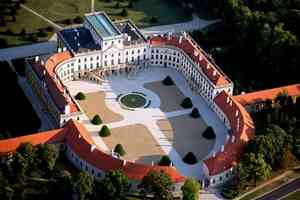 The Eszterháza Palace Source: Manitou Winds |
| Born
on 21 June 1732 in
Leipzig,
Johann Christoph
Friedrich Bach
is a lesser known of the better known of the Bach musical dynasty
[1,
2,
3] as
a son of Johann
Sebastian Bach. JCF Bach was a transitional figure from late Baroque to early
classical who also composed in the galant style. He studied at the famous
St. Thomas School
w his father before his first professional appointment in 1750 in Bückeburg
[1,
2] as a
harpsichordist to Count William of Schaumburg-Lippe.
That worked out nice, as Bach became konzertmeister
in 1759, henceforth to remain at the Court of Bückeburg for the rest of his
career. He is thus called "the Bückeburg Bach" to distinguish him from the
others. Between the years of 1765 and 1772 Bach completed nine symphonies. His initial oratorios arrived
in '69 per 'Die Pillgrimme
auf Golgatha' w text by Friedrich Zachariae and the Passion cantata, 'Der
Tod Jesu' ('The Death of Jesus'), the latter to the 1760 revised libretto by Karl Ramler. Ramler's
original version had been set to music by
Carl Heinrich Graun
in 1755
and
Georg Philipp Telemann in '56.
In 1771 Johann Gottfried Herder arrived to Bückeburg with whom
Bach collaborated on several works including 'Die Kindheit Jesu' ('The
Childhood of Jesus') that
premiered on 11 Feb of 1773 [*;
audio]. They produced their 'Die Auferweckung Lazarus'
('The Resurrection of Lazarus' BR D 6) that year as well [1,
2]. Come 'Michaels Sieg' circa 1775 before Herder
moved onward to a position in Weimar in '76. Bach traveled to London in 1778 to visit his brother,
Johann Christian Bach. IMSLP bears a date of 1787-88 for his four-book
collection, 'Musikalische Nebenstunden' ('Musical Leisure Hours') in which
he included the song by his son, W.F.E. Bach,
'Seid gegrüßt, ihr grünbemooste Hügel'. Bach spent 1792
into 1794 writing ten more symphonies before his death in Bückeburg
on 26 January 1795. In addition to symphonies Bach's claim to
fame consists of keyboard pieces, largely sonatas, chamber music and
concertos. He also wrote arias and incidental music.
References: 1,
2,
3,
4,
5.
Works: 1,
2,
3,
4,
5.
Scores.
Editions: 1,
2,
3.
Audio: 1,
2,
3.
Recordings of: discos: 1,
2;
'Die Kindheit Jesu' (1773): 1,
2;
'Sonatas & Trios' by the Camerata Köln.
Further reading: Georg Predota (Bach's marriage to Lucia Elisabeth Münchausen).
Biblio: 'C.P.E. Bach' by David Schulenberg (Routledge 2017).
Per below, BR numbers are per the
Bach-Repertorium (BR) research group.
WFV, WfV or variants are per Hannsdieter Wohlfarth 1971. Johann Christoph Friedrich Bach BR C37 Orchestre de Chambre du Festival d`Echternach Yoon K. Lee BR D5 'Schlummre sanft' Alt-Mezzo: Kathrin D. Widmann 1768 WFV I:3 Concerto Koln |
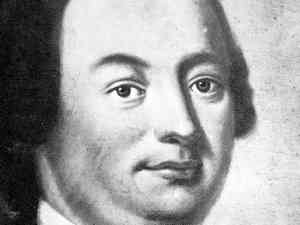 Johann Christoph Friedrich Bach Source: Codalario |
|
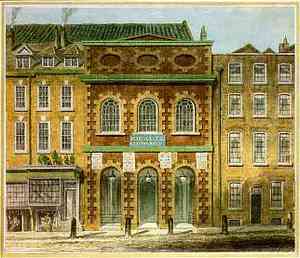 Her (His) Majesty's Theatre (Queen's Theatre King's Theatre) Source: Wikipedia |
Born in Leipzig, Germany,
on 5 Sep 1735,
Johann Christian Bach was a member of the Bach musical dynasty [1,
2,
3]. His
father, Johann Sebastian Bach,
died when Johann Christian, his youngest son, was fifteen. His brother,
Carl Philipp Emanuel Bach, was 21 years his senior. Johann Christian no
doubt received musical instruction from his father as a child. In 1756 he
went to Italy to study under
Giovanni Battista Martini in Bologna. In 1760 he became a church
organist in Milan, also dropping Luther for Catholicism about that time.
1762 found Johann in London producing opera at the
King's
Theatre. King's
Theatre was the place to perform in England. To the left is a
drawing of the theatre as it would have appeared in Bach's time, before its
major reconstruction in 1791. King's Theatre was erected in 1705 as Her
Majesty's Theatre (Queen's Theatre), its name changing per gender of the
monarch. As for John, he soon became music master to Sophia Charlotte
of Mecklenburg-Strelitz, wife of King George III. In the meantime, JC met
Mozart in London in 1764 when the latter was eight years old. Bach
tutored
Mozart for about five months, the latter owning a good esteem of Johann's
music. Mozart
found nice things to say about any musician, but in John's case he was
sincere, arranging three of the latter's sonatas into concertos. Another of the
figures in Bach's life was of less positive value, Johann having the
misfortune of employing a steward who stole the majority of his wealth, such
that he died in debt in London on New Year's Day in 1782. Charlotte paid
his debts and put his widow on a pension. Johann had been popular composing
in the galant style. But as galant faded out of favor in the seventies so
did Bach. Of the more than ninety
symphonies ascribed to him only 48 have been confirmed. An industrious
composer, he otherwise wrote a lot of keyboard and chamber music (sonatas
and quartets). He composed a good number of concertos
and concertantes for orchestra. Concertantes are concertos lite,
emphasizing instrumental solos. Johann also authored a good number of canzonettas
(light songs originating in Italy in the prior century), arias, liturgical pieces and
incidental music. References: 1,
2,
3,
4.
Compositions: 1,
2,
3,
4,
5,
6.
Manuscripts & scores: 1,
2,
3.
Editions: 1,
2.
Audio: 1,
2,
3,
4,
5.
Discos: 1,
2,
3,
4,
5.
Further reading: Tom Service.
Bibliography.
Other profiles: 1,
2,
3,
4,
5.
As of below, cataloguing is per Ernest Warburton's 48-volume 'The Collected Works of Johann Christian Bach'
published by Garland from 1984 to 1999 [1,
2,
3]. Johann Christian Bach 1779 W G:39 Opera Solamente Naturali Musica Florea Didier Talpain 1759 W E:4 Choeur de chambre de Namur L'ensemble Les Agrémens Wieland Kuijken No 1-7 W C:55-60a Piano: Anthony Halstead 1776 W G:9 Opera Mozarteumorchester Salzburg Ivor Bolton W H:26 'Come Colin, pride of rural swains' W H:35 'Would you a female heart inspire' W H: 27 'Ah, why shou'd love with tyrant' Boyd Neel Orchestra Soprano: Elsie Morrison W H:31 'Lovely yet ungrateful swain' W H: 36 'Cease a while ye winds to blow' Boyd Neel Orchestra Soprano: Elsie Morrison 1763 W G:5 Opera Opera Fuoco/David Stern |
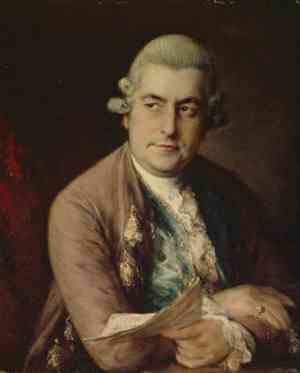 Johann Christian Bach 1776 Painting: Thomas Gainsborough Source: Wikipedia |
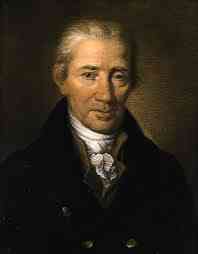 Johann Albrechtsberger Source: Raptus Association |
Born on 3 Feb 1736 in Klosterneuburg, Austria,
Johann Georg Albrechtsberger
was taught music by Augustinians when he became a choir boy in
Klosterneuburg at age seven. He there learned thoroughbass and organ, there
apparently an organ built just for him per Aryeh Oron at Bach Cantatas [ref
3]. In 1749 Albrechtsberger shifted over to the Benedictines at Melk Abbey in Vienna
where he prepared for study in philosophy in 1754. He
began working as an organist in Raab in 1755 with a firm acquaintance of such
as counterpoint. He shifted over to Maria Taferl in 1557, then
returned to Melk Abbey before assuming a similar position at the court of
Vienna in 1772. Two decades later he became Kapellmeister of
St. Cathedral (1792). He died in Vienna on 7 March 1809, leaving a legacy of
300 keyboard works (organ intensive), 300 sacred works and about 240 others. Albrechtsburger
remains better known, however, as a
theorist and teacher, with an impressive list of pupils including
Beethoven.
His 'Gründliche Anweisung zur Composition' had been published in 1790
[*],
issued twice more in 1804 and 1821. In 1826 prior student, Ignaz von
Seyfried, published 'J.G. Albrechtsberger's Collected Writings on
Thoroughbass, Harmony & Composition', an altered and expanded version of
Albrechtsberger's prior work [*]
that got translated into English by Mary Novello before publishing
by Vincent Novello in 1855. References: 1,
2,
3.
Compositions: 1,
2,
3,
4.
Scores.
Editions: 1,
2,
3,
4,
5;
'Collected Writings on Thoroughbass, Harmony & Composition' (Novello 1855/1870) *.
Audio: 1,
2,
3.
Discos: 1,
2,
3.
Other profiles: 1,
2,
3,
.
Johann Albrechtsberge 1777 Flute: Pál Németh Keyboard Concerto in B flat major Amadeus Chamber Orchestra/Freddy Cadena Piano: A. Bachchiev Organ 4 hands: Fabio Ciofini & Jordi Vergés String Quartet in C major Op 7:4 Allegro moderato The Authentic String Quartet String Quartet C major Op 20:5 1798? |
|
| Born in Prague
on 9 March
1737 to an upper-class mill owner,
Josef Mysliveček
attended Charles-Ferdinand University. Returning to the trade of his father,
Mysliveček became a master miller in 1761, only to quit that profession to
study music, which he did with
Josef Seger.
Myslivecek is the first musician in these histories who didn't study music
as a child, he twenty-four years old before taking up music. In 1763
he journeyed to Venice to study under Giovanni Pescetti. Myslivecek's first opera, 'Semiramide',
was performed at the Teatro di Citadella in Bergamo in northern Italy in the summer of 1766 [*]
w a libretto by Metastasio.
That was a strong work,
yet only the potential of Myslivecek's second opera, 'Il Bellerofonte' [*], that premiered on 20 January 1767 at the Teatro San Carlo in Naples
w a libretto by Giuseppe Bonecchi. Myslivecek's third opera was 'Farnace' w
libretto by Antonio Maria Lucchini premiering on 4 November 1767 in Naples
at the Teatro San Carlo [1,
2].
It was a libretto by
Metastasio again for 'Il trionfo di Clelia' premiering
at the Teatro Regio Turin on 26 December 1767 [1,
2] Myslivecek would set a
total of sixteen of
Metastasio's texts for opera during his career. It was
an oratorio by
Metastasio called 'La passione di nostro Signore Gesu Cristo'
in 1773, which Antonio Caldera had first put to music in 1730
[1,
2]. Mysliveček never married, but he could count
Mozart among his friends, they first meeting in 1770 in Bologna when
Mozart was fourteen to remain in contact until 1778,
about the time things began to turn sad for Myslivecek concurrent w becoming victim to tertiary syphilis, resulting in the disfigurement of his
face, worsened by a doctor attempting to cure it. In as little time as it
took to learn composing and produce his first successful opera in the early sixties Myslivecek went from "full of fire, spirit and life" as
Mozart described him
to spending the last few years of his life ill and not real popular for it
while composing failures like 'Armida' [*]
which kept him in poverty. That may or may not have premiered
anonymously in Lucca as early as August of '78, but was certainly performed
in Milan on 26 Dec of 1779. Mozart had nevertheless been drawn to the aria, 'Il caro mio bene', in Act III, Scene I,
which Myslivecek had earlier written in 1773 or '74.
Mozart rearranged it w a different text to his own purposes
as 'Ridente la Calma' sometime between '73 and '75, catalogued as KV 152 (K⁶ 210a)
[*].
Metastasio's sixteenth and last libretto put to music by Myslivecek was also
his last opera, 'Antigono', premiering at the Teatro delle Dame in Rome on 5
April 1780 [*].
Metastasio's 'Antigono' had first been set to music in 1744 by
Johann Adolph Hasse.
It's not be confused with the earlier 'Antigona' by Mysliveček w libretto by Gaetano Roccaforte that premiered at the Teatro Regio in Turin on 26 December 1773
[*;
audio]. Howsoever, Myslivecek's fall from
charm and a highly promising career to cathedral
gargoyle arrived rapidly, he dying not yet 44 years of age on 4 Feb 1781, likely of
syphilis. Along w his oratorios and 26 opera serie Myslivecek had written
concerti, sonatas and symphonies, joining such as
Cristoph Gluck as one of the more important Czech composers of his
period who, though spending nigh all of his career w a few brief exceptions in Italy, helped put the
Bohemian region on the map during the classical era as "il Buomo" (the
Bohemian). References: 1,
2.
Compositions: 1,
2,
3,
4;
operas: 1,
2.
Scores: 1,
2.
Editions: 1,
2,
3.
Audio: 1,
2,
3.
Recordings of: discos: 1,
2;
'La passione di nostro Signore Gesu Cristo' (oratorio of 1773 w libretto by
Metastasio) performed by
the Chorus Musicus Kiln & Das Neue Orchester w Christoph Spering
1,
2.
Further reading: Daniel J. Wakin.
Biblio: 'Josef Myslivecek 'Il Boemo''
by Daniel Freeman (Harmonie Park Press 2009): review.
Other profiles: 1,
2. Josef Mysliveček 1776 Oratorio Kühn Mixed Choir Sinfonietta Praha Ivan Parik Camerata Chicago/Drostan Hall Cello: Wendy Warner 1767 Opera Czech Philharmonic Chorus Prague Chamber Orchestra Zoltan Peskó First performance 1771 Florence Opera The Czech Ensemble Baroque La Passione di Nostro Signore Gesu Cristo 1773 Oratorio Chorus Musicus Köln/Das Neue Orchester Christoph Spering <1772 Dvořák Chamber Orchestra Libor Pešek Violin: Shizuka Ishikawa <1772 Dvořák Chamber Orchestra Libor Pešek Violin: Shizuka Ishikawa <1772 Dvořák Chamber Orchestra Libor Pešek Violin: Shizuka Ishikawa |
||
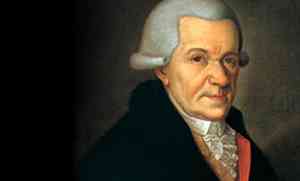 Johann Michael Haydn |
Born
on 14 Sep of 1737 in Rohrau, Austria,
Johann Michael Haydn
was the younger brother of
Joseph Haydn.
His father was a wheelwright and village mayor. He also played harp. About
1745 Haydn became a singer at St. Stephen's Cathedral in Vienna. The greater
majority of Haydn's compositions are difficult for scholars to date with
precision, but his Missa, 'SS Trinitatis' MH 1, can be dated to as early as
1754 in Vienna. "MH 1" translates to the chronological catalogue of Sherman & Thomas (Pendragon Press 1993)
of above eight hundred works. Though most dates in the Sherman & Thomas are
estimated, it has been preferred since its publishing to the
'Perger-Verzeichnis'
of 1907 which goes by type of work, then chronology, and found to have
numerous errors. Comparatively, Perger 1 is 'Symphony No. 1C in E flat
major' [*] which is MH 35 in Sherman & Thomas probably composed sometime between
1757-60 in
Nagyvárad. Meanwhile 'Symphony No. 1 in C major' [1,
2]
is Perger
35 and MH 23 likely written before 1761. It was 1757 when Haydn
was appointed Kapellmeister to the court of the Bishop of Grosswardein in Nagyvárad. Situated from Austria across some 200
miles of present-day Hungary in Oradea, Romania, that makes Haydn the most
eastern-bound composer in these histories thus far, nigh doing a loop from
where these histories began in Constantinople 1200 years prior, then to Rome
and Western Europe, now to weave back to the more eastern reaches of Western
empire In 1763 Haydn became
Kapellmeister to Archbishop Schrattenbach
in Salzburg. He had by that time already completed 15 symphonies, 14 Masses,
six divertimentos for three-string instruments as well as multiple wind
partitas and concertos. Haydn also worked as an organist at the Dreifaltigkeitskirche
(Church of the Holy Trinity) in Salzburg. Haydn remained in Salzburg the
remainder of his career. Into the seventies came his 'Symphony No. 15 in D
major' (Perger 41/MH 150) likely sometime after August 1771
[*]. Into the
eighties Haydn set Luigi Gatti’s 'Missa Sancti Ruperti' into C major MH 322
in 1782 [*], also known by
other titles including 'Jubiläumsmesse'
[audio]. He
spent the next twenty-four years composing prolifically until his death in Salzburg on 10 August 1806. Haydn
had written more than 400 pieces of sacred music,
including a good number of antiphons (a kind of responsorial by choir or
congregation), canticles (diminutive to "songs" in Latin, being texts taken from
Scripture other than David's 'Psalms'), graduals (antiphons sung
between the Epistle and the Gospel in the Eucharistic service) and settings
to Masses. In addition to symphonies, his secular instrumentals include a strong number of serenades. Haydn's many pieces for voice include 65 canons. (A canon is
an instrumental or vocal work in which the same music is begun at different
times. The nursery song, 'Row, Row, Row Your Boat', is an apt example.)
References: Bach Cantatas;
'New Grove Dictionary of Music and Musicians' ed. by Stanley Sadie (MacMillan 2001)
*;
Wikisource; Wikipedia:
1,
2,
3.
Compositions:
1,
2,
3,
4,
5 (Catalan),
6 (Czech),
7 (Francais),
8 (Francais);
symphonies: 1,
2 (Francais).
Scores: 1,
2,
3,
4,
choral works,
'Ein Lob- und Danklied'
('A Song of Praise and Thanks'). Autographs. Editions: 1,
2,
3. Audio:
1,
2,
3,
4,
concertos,
Masses,
symphonies.
Discographies: 1,
2. Further reading:
'Michael Haydn’s Early Masses and Their Viennese Context' by
Bruce C. MacIntyre.
Biblio: 'Michael Haydn and 'The Haydn Tradition'' by Dwight Blazin.
See also Wikimedia Commons.
Other profiles: Czech;
English: 1,
2,
3,
4,
5;
Deutsch: 1,
2,
3,
4,
5,
6,
7,
8,
9;
Francais: 1,
2;
Italian;
Japanese;
Romanian;
Russian;
Slovak;
Swedish.
Johann Michael Haydn Gloria et Credo ad Missam Sancti Gabrielis MH 112 C major Cantores Carmeli/Michael Stenov MH 43 Choir and Orchestra of St. Peter/Paul Rott am Inn Missa pro Defuncto Archiepiscopo Sigismundo 1771 MH 155 Requium Ensemble Pygmalion/Raphaël Pichon Missa Tempore Quadragesimae in D minor MH 553 Credo Ex Tempore/Florian Heyerick 1806 MH 838 KammerChor Saarbrücken Kammerphilharmonie Mannheim Georg Grün MH 134 Orchestre de Chambre National de Toulouse Alain Moglia Horn: André Cazalet Trombone: Michel Becquet MH 104 Münchener Kammerorchester/Hans Stadlmair Trumpet: Maurice André Violin Concerto in B flat major MH 36 Camerata Salzburg/Lukas Hagen Violin: Lukas Hagen |
|
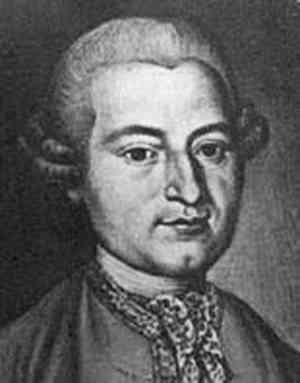 Leopold Hofmann Source: Musicalics |
Born in Austria to a ranking civil servant on 14 August 1738,
Leopold Hofmann
sang into nice digs at age seven, serving as a chorister to Holy Roman
Empress Elisabeth Christine, his director and teacher
František Tůma. He continued his
studies in composition, harpsichord and violin under a couple more notable
teachers until securing a position in 1758 at St. Michael's in Vienna as a musicus (professional composer
or conductor). 1764 found him choral director at
St. Peter's Church, then Kapellmeister in 1766. Three years later Hofmann
was teaching music to the royal family. In 1772 he became Kapellmeister at
St. Stephan's. In 1791
Mozart became
an assistant to Hofmann, who was ill, thinking he might be required to
assume Hofmann's position. But
Mozart died
(1791) before Hofmann did, the latter on 17 March 1793. The largest portion of
Hofmann's oeuvre consists of concerti and symphonies. Despite his stature at
the time scholars remain unable to date his works, most falling between the
latter fifties and latter seventies. Hofmann's symphonies were catalogued by
George Cook Kimball in 'The Symphonies of Leopold Hofmann (1738–1793)'
(Columbia University 1985). His concertos were catalogued by
Allan Badley in
'The concertos of Leopold Hofmann (1738–1793)' (University of Auckland
1986). His Op. 1, No. 1, however, is a sonata in A major for viola,
violoncello and cello estimated about 1774
[1,
2].
Lending example of his works are his flute and cello concertos such as
'Flute Concerto in D major' (Badley D1), his best-known work as it was once
thought to have been written by
Franz Joseph Haydn [1,
audio].
Badley D2
is his 'Cello Concerto in D major' probably composed sometime in the
sixties. Badley D3 is another 'Cello Concerto in D major'
[1,
audio]
perhaps written in the early seventies. Badley G1 is his 'Flute Concerto in
G major' likely written in late career [*, audio:
1,
2].
References: 1,
2,
3,
4. Compositions:
1,
2,
3.
Scores.
Editions: 1,
2.
Audio: 1,
2.
Recordings of: discographies: 1,
2,
3;
'Flute Concertos Vol 1' w flute by Kazunori Seo w the Esterhazy Sinfonia & Bela Drahos;
'Flute Concertos Vol 2' w flute by Kazunori Seo w the Esterhazy Sinfonia & Bela Drahos;
'Flute Concertos · 3' w flute by Uwe Grodd w the Czech Chamber Philharmonic Orchestra & Pardubice Michael Halász.
Other profiles: 1,
2,
3.
Leopold Hofmann B II:D4 Flute: Maria Filippova Czech Radio Symphony Orchestra Conducting: Jan Talich |
|
|
Baptized in Mannheim
on 8 May
1745,
Carl Stamitz
was the eldest son of
Johann Stamitz and elder brother to
Anton Stamitz [Stamitz family
of composers]. He also trained
under
Christian Cannabich. Early
employed as a violinist by the court in Mannheim [of especial importance to
the classical period: 1,
2,
3,
4,
5], he began traveling as a
virtuoso in 1770, including Paris, London, Saint Petersburg, the Low
Countries, Prague and about Germany. Settling in Jena in 1794, he died in
poverty on 9 November 1801. Stamitz composed above 50 symphonies, more than 38 symphonie concertantes and at least 60 concertos.
Otherwise lending example of his music is his 'Quartet in E flat Major' Op.8
No.4 for clarinet or oboe, violin, viola and cello published in 1773
[1,
audio].
References: 1,
2,
3.
Compositions: 1,
2,
3,
4,
5,
6.
Scores: 1,
2,
3,
4,
5.
Editions: 1,
2,
3.
Audio: 1,
2,
3,
4,
5.
Discos: 1,
2,
3,
4,
5.
Other profiles: 1,
2,
3,
4,
5,
6,
7.
Carl Stamitz Etienne Boudreault Ernst Kovacic Steven Dann Anssi Karttunen Movement 1 Prague Chamber Orchestra Cello: Christian Benda Movements 2 & 3 Prague Chamber Orchestra Cello: Christian Benda II: Romance: Andantino III: Rondo: Allegretto Prague Chamber Orchestra Cello: Christian Benda Flute Concerto in G major Op 29a Flute: Soomin Viola Concerto in D major Op 1 Collegium Aureum/Franzjosef Maier Viola: Ulrich Koch |
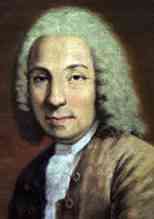 Carl Stamitz Source: Classical Connect |
|
| Born
on 26 June 1747 in Velvary, Bohema (now Czech Republic), Jan Antonín Koželuh changed his name
in 1774 to
Leopold Koželuch
to avoid confusion with that other composer younger by about a decade.
The Bohemian region nestled largely between Austria, Germany and Poland,
and was a Prussian war zone under
Frederick II (the Great)
who had begun his reign in 1740. Commencing that struggle were the first two
Silesian Wars of 1740-45 along w the War of Austrian Succession in 1740-48
and the Seven Years War between 1756 and 1763.
Frederick II
was himself a musician who's court was held in Prague about 230 miles east
as the bird flies from Mannheim in the German region, a key location in the
development of classical music [1,
2,
3,
4,
5]. Mannheim was a property of Charles III
Philip, Elector Palatine, until 1742, then Charles Theodore who later became
Elector of Bavaria, briefly before dying, in 1777 to be succeeded by
Maximilian I Joseph. Also continuing in juxtaposition was Lutheranism in
Germanic Europe versus the
Catholicism of the Holy Roman Empire. In addition, Freemasonry [1,
2,
3,
4,
5,
6], originating
in the 15th century in England, had by the classical period become of
persuasion in political matters. Both Koželuch and
Frederick II, the latter
allied w the British,
were Freemasons. Such the immediate theater into which Koželuch
had been born, no German Elector Palatine especially fond of
Frederick II. Among
Koželuch's teachers in the early seventies was František Dušek. His first
work was a ballet for the National Theater in Prague in 1771 for which
composed for the next twenty-five seasons. In 1778 Koželuch journeyed to
Austria where he studied under
Johann Albrechtsberger. Koželuch established a publishing house in 1784. In 1792 he became not only court composer
and Royal Orchestra Master to Austrian and Holy Roman Emperor Franz II upon the death of
Mozart, but he was
paid twice
Mozart's salary.
He there remained until his own passing on 7 May 1818. Koželuch was better known as a piano virtuoso during his
time than as a composer since then. Though published and popular
throughout Europe, fellow composers such as
Mozart and
Beethoven
were critical. Koželuch's legacy consists of about 400 works including some thirty
symphonies, 22 piano concertos and 63 piano trios. His Op, 1 was 3 sonatas
published in 1780 [1,
audio].
References: 1,
2,
3.
Compositions: 1,
2,
3.
Manuscripts and scores: 1,
2.
Editions: 1,
2.
Audio: 1,
2,
3,
4;
symphonies.
Recordings of: discos: 1,
2,
3,
4,
5;
'Complete Keyboard Sonatas' w fortepiano by Kemp English:
Vol 1;
Vol 2: *,
audio;
Vol 3: *,
audio;
Vol 4: *,
audio;
Vol 5: *,
audio;
Vol 6: *,
audio;
Vol 7: 1,
2,
audio;
Vol 8: *,
audio;
Vol 9;
Vol 10;
Vol 11;
Vol 12;
'Symphonies · 1' by the Czech Chamber Philharmonic Orchestra Pardubice w Marek Štilec;
'Symphonies · 3' by the Czech Chamber Philharmonic Orchestra Pardubice w Marek Štilec.
Other profiles: 1,
2,
3,
4.
P numbers below are per
Milan Poštolka in 'Leopold Koželuh: život a dílo', 1964 [*].
The catalogue begins w P 1:1, a symphony in D major called 'L'Arlechino'. Leopold Koželuch P 4:1 Op 12 Slovak Sinfonietta Žilina Oliver von Dohnány Piano: Tomas Dratva P 12:37 Op 38:3 I: Allegro agitato Piano: Anna Petrova-Forster P 12:37 Op 38:3 I: Largo Piano: Anna Petrova-Forster P 12:37 Op 38:3 II: Allegretto Piano: Anna Petrova-Forster P 16:1 Oratorio Rheinische Kantorei Das Kleine Konzert Hermann Max Sinfonia concertante in E flat major P 2:1 Academy of St. Martin in the Fields Consortium Classicum Iona Brown P 1:6 Op 24:1 Concerto Köln/Werner Ehrhardt |
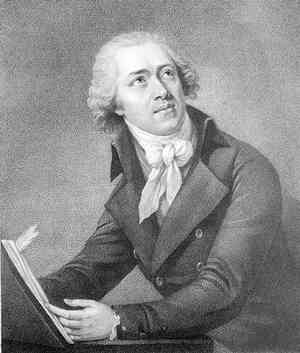 Leopold Kozeluch Engraving: W. Ridley Source: My Art Prints |
|
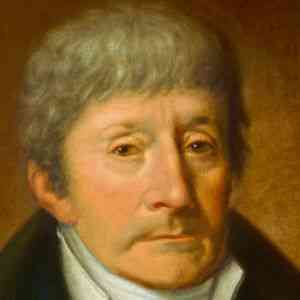 Antonio Salieri Source: Bio |
Born
on 18 August 1750 in the
Republic of Venice,
Antonio Salieri was a major
classical composer in the big leagues w such as Mozart. His main claim to fame was
Italian opera for
three languages and a nova-like culmination of classical opera before the
Romantic to come. Salieri was
orphaned in 1763/64, upon which he was taken in by a monk in Padua, then in
Venice by one Giovanni Mocenigo, a connected nobleman. Receiving instruction
from
Giovanni Pescetti,
then a lesser-known opera singer, he was taken to Vienna for tutoring in
1766 by composer, Florian Leopold Gassmann. Among his concluding studies w
Gassmann was his unpublished opera, 'La Vestale', of 1768 w libretto by an
unknown. As Gassman was in the employ of Holy Roman Emperor Joseph II,
Salieri also also associated w as
Christoph Willibald
Gluck and
Metastasio
at that court. From the latter he received instruction such that in 1770
he produced his first opera, a buffa titled 'Le donne letterate' [*] w
libretto by Boccherini after Molière's 'Les Femmes Savantes'. In latter 1776
Salieri premiered his oratorio, 'La passione di Gesù Cristo', w a libretto
authored by
Metastasio
back in 1730 [1,
2,
3,
audio]. In 1778 Salieri
left Austria for Italy, writing his 'Picciola Serenata' in B-flat major
about that time [1,
2,
3]. He opened 'Europa Riconosciuta' in Milan [*,
audio]
on 3 August of '78. Salieri staged other
operas in Venice and Rome before returning to Vienna to premiere 'Der Rauchfangkehrer'
('The Chimney Sweep' *) at the Burgtheatre on 30 April. He then rattled his wheels
to Munich where he staged his only opera w a libretto by
Metastasio,
'Semiramide riconosciuta' [*], on 14 January of 1782. Composed
53 years earlier, that had been set to music
numerous times beginning w Leonardo Vinci back on 6 Feb 1729. A short while
after Salieri's production
Metastasio
died in April of '82 in Vienna. In 1783 or '84 Salieri went
Paris to work with
Christoph Gluck,
resulting in the performance of 'Les Danaïdes' on 26 April 1784 by the Paris
Opera (founded 1669)
[1,
2,
3;
audio;
reviews: 1,
2].
Gluck had largely
begun 'Les Danaïdes'
before hiring Salieri to finish it, crediting Salieri w the whole thing.
Back in Vienna for a few more operas, sometime in 1785 Salieri collaborated
Mozart and an unknown Cornetti toward 'Per la ricuperata salute di Ofelia', a
cantata w libretto by Lorenzo Da Ponte
[1,
2,
3;
audio]. Salieri headed back to France to premiere
'Les Horaces' at either Fontainebleau on 2 Nov 1786 or Versailles on 2 Dec
1786. Albeit that performance by the Paris Opera flopped, 'Les Horaces' is recognized as an
impressive work [1,
2;
audio;
reviews: 1,
2,
3].
Come 'Tartara' performed by the Paris Opera on 8 June of 1787 [1,
2],
that a huge success due to the libretto by Pierre Beaumarchais in tune w the
zeitgeist of the period just prior to the outbreak of the
French Revolution
in 1789 with monarchs and priests losing popularity contests. Returning to Vienna in 1788, Salieri's
protector, Holy Roman Emperor Joseph II, died in 1790. Salieri's position to
the court as director of Italian opera was then retired in 1792, though he
continued to work on commission. As the calendar flipped into the 19th
century Salieri's works began losing audience. His last opera, a singspiel titled 'Die
Neger' [The Negroes': 1,
2], was performed in 1804, written by Georg
Treitschke with drama set in Virginia (U.S.). As that was a failure like
'Annibale in Capua' [1,
2] before it in 1801
(w Hannibal performed by a castrato), Salieri withdrew from theatrical composing to
teach, Ludwig van
Beethoven,
Franz Liszt and
Franz Schubert among his
pupils. By that time theatrical music was undergoing the shift toward the Romantic
period, a transition Salieri didn't wish to pursue. The master had reached
his limit w theatre, then pulled out before overmuch damage by recent
failures.
Changing his approach to cantatas, oratorios and songs, he completed his final work
in 1815: '26 Variations on 'La follia di Spagna'' [1,
2]. Salieri's last years
had been
something more depressing than they should have been, the rumor afire that
he had poisoned
Mozart to death in 1791
[1,
2,
3,
4 (Ian Kyer),
5,
6]. Albeit
Mozart and Salieri
had definitely been professional rivals, an overall personal enmity between
them, if any really, seems likely exaggerated by national prejudices
(Austrian v Italian) and storytelling. A fall in 1823 left Salieri with dementia
until his death on 7 May 1825 [*]. He had completed thirty-seven staged operas amidst
his greater oeuvre. References: 1,
2,
3,
4,
5 (extensive).
Compositions: 1,
2,
3,
4,
5,
6;
operas: 1,
2,
3.
Manuscripts & scores: 1,
2,
3;
choral works.
Editions: 1,
2.
Audio: 1,
2,
3,
4,
5;
operas.
Recordings of: discos: 1,
2,
3,
4,
5,
6;
'Europa Riconosciuta' directed by Luca Ronconi
*;
'Overtures' by the Slovak Radio Symphony Orchestra w Michael Dittrich:
audio,
review;
'La Passione di Gesù Cristo' by the Chorus Musicus Köln & Das Neue Orchester w Christoph Spering
*.
Further reading: Francesco Blanchetti,
Michael Lorenz,
Harold Schonberg,
David Wright.
See also: National Arts Center Pocast interview w Ian Kyer:
1,
2.
Biblio: 'Antonio Salieri and Viennese Opera' by John A. Rice (U of Chicago Press 1998)
*;
'Dwight's Journal of Music' Vol 24 No 6 June 1864
*.
Other profiles: books: 1,
2,
3,
4,
5;
internet: 1,
2,
3,
4,
5. Antonio Salieri 1815 London Mozart Players Matthias Bamert Also 'Hofkapellmeistermesse' or 'Kaisermesse'1788 'Emperor' St. Florianer Sängerknaben Leondinger Symphonieorchester Uwe Christian Harrer First performed 1785 Vienna Opera Choeur de l'Opéra de Lausanne Les Talens Lyriques Christophe Rousset First performed 1785 Vienna Opera Choeur de l'Opéra de Lausanne Les Talens Lyriques Christophe Rousset First performed 1786 Vienna Opera Concertgebouw Orchestra Amsterdam Nikolaus Harnoncourt First performed 1787 Paris Opera Orquestra Ars Musicae de Mallorca 1804 Coro Gulbenkian Orquestra Gulbenkian Lawrence Foster |
|
| Mandolinist and
keyboard player,
Jan Křtitel Kuchař (Johann
Baptist Kuchař),
was born on 5 March 1751 in the Czech region of Hradec Králové (now Czech Republic,
its northern border Poland). Kuchar was a Jesuit seminarian who then studied
under
Josef Seger in Prague before
becoming an organist at the Church of St. Jindrich. He also began teaching.
Meeting Mozart in
1787, the pair were on friendly terms. Kuchar became a Freemason about that
time. Up to this era music in Europe has witnessed the schism between the
sacred and secular as well as the Catholic and Protestant. Schools and
academies have long since arrived. Now enter another brand of institutional influence in
society and music, that Freemasonry. Freemasonry [1,
2,
3,
4,
5,
6], originating
in the 15th century in England, began to notably appear in association with
music during
the classical period, especially in the Czech vicinity of Europe allied w
England [see
Frederick II,
Leopold Koželuch]. As for
Kuchař, in
1790 he traded his position in Prague for a monastery in Strahov. The next
year he began conducting in Prague, from which he resigned in 1800. He died
in Prague on 18 Feb 1829. Though not a major composer and become obscure since his times, Kuchar was nevertheless notable among his contemporaries.
References: 1,
2,
3.
Compositions: 1,
2,
3,
4.
Editions.
Audio: 1,
2,
3.
Recordings of: 1,
2,
3. Jan Krtitel Kuchar Organ: Ondřej Mucha Organ: Jaroslav Tuma Organ: Jaroslav Tuma Organ: Jaroslav Tuma
|
||
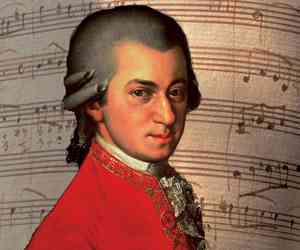 Wolfgang Amadeus Mozart Source: Band of Artists |
Born
0n 27 Jan 1756 in
Salzburg, Austria,
Wolfgang Amadeus Mozart
had some kind of antennae to some kind of extraintelligence that brought him
to personification of the classical period as indisputable crown of European music over the centuries up to
his time. Mozart wrote his first compositions at age five. His first surviving composition was
once believed to have been 'Minuet in G' for
keyboard' K 1 [1,
2,
audio]
also listed as K 1 and K 1e ("KV" for the 'Köchel Verzeichnis' is sometimes used rather than K). That was part of a set of three other minuets and an allegro written
in Salzburg
in '61-'62 at age five to perhaps six. Other pieces were discovered in 1954 which
scholars place as his first at age five, specifically 'Andante in C' K 1a in
a folio called 'Stucke aud dem Nannerl-Notenbuch'
[1,
2,
3,
4,
5,
audio].
There are six K catalogues, the first published in 1862 by Ludwig von
Köchel [*;
catalogue]. A second edition addressed errors in the first until Albert Einstein
(physicist) wrote his directory, K3, in 1936. The latest, K6, was published
in 1964 by Franz Giegling, Alexander Weinmann and Gerd Siever. See also the
Köchel catalogue: English
(alt),
Czech,
Italiano.
Mozart catalogued his own works as well, beginning on 9 February 1784 with 'Piano Concerto
in E-flat No. 14' [K 449: 1,
2,
3
(alt),
4,
5,
audio]. See the ‘Verzeichnüss aller meiner
Werke' 1,
2;
autograph: 1,
2,
3. Mozart's father,
Leopold Mozart [1,
2,
3,
4], was a violinist who had published a
violin textbook. Wolfgang received instruction from his father along w his sister, Nannerl, four years older
than he and also a skilled harpsichordist [1,
2,
3,
4,
5,
6,
7]. In 1762
Mozart's father began taking his children on tour for the next three years,
visiting Munich, Vienna, Prague, Paris, Zurich and London. Mozart wrote his
first symphony at age eight in 1764: 'Symphony 1 in E flat major'
[1,
2,
3,
4; audio:
BBC,
Hyperion].
His first operatic work was a singspiel, K 35: Part 1 of 'Die Schuldigkeit des ersten Gebots'
w Part 2 composed by
Johann Michael Haydn and Part 3 by Anton Adlgasser [1,
2,
audio]. With libretto by
Ignaz von Weiser, that premiered on 12
March 1767 at the palace for archbishops, Salzburg Residenz. In
1769 Leopold (Mozart's father) began touring Italy with Mozart alone, Rome
and Milan in particular, leaving Nannerl and his wife at home in Salzburg.
They were on such less-than-convenient journeys by carriage that Mozart at
least sketched many of his compositions. In 1773 Mozart was hired as court
musician to Count Hieronymus von Colloredo in Salzburg. Unfortunately he was
paid only 150 florins a year, a very good wage for someone 17 years old but
far short of the average of about 300 florins for the standard composer.
Thus Leopold and Wolfgang began traveling again, searching for a benefactor
in Vienna, Munich, Augsburg, Mannheim, Paris, and Strasbourg, meanwhile
resigning from the court of the Count in 1777, only to return in 1779,
though to the comfortable salary of 450 florins now, with the Count an
Archbishop by then. It was '79 when Mozart composed his Mass Ordinarium
[1,
2],
'Coronation Mass' No. 15 in C major, K 317
[1,
2,
3,
audio].
That is also seen as No. 16
[audio: 1,
2,
3]. In
early 1781 Mozart was summoned to Vienna by the Archbishop Colloredo, but there was the schism of social class between them, and Mozart's
was an independent attitude wont to doing things like approaching a Russian
ambassador, without permission, to start a conversation. As musicians were
to be heard, not seen, Mozart's final request to resign from the Court was
answered with a literal boot to the glutei maximi in May of '81 [*]. Worse, Mozart's father
had wished conciliation. Howsoever, the occasion marks the times: once opera
had come on the scene (Jacopo Peri in 1597)
musicians had begun to less depend on nobility and more on tickets sold.
Nobility in Europe had been gradually descending in financial capacity for
more than a century as free enterprise had begun to develop another class
system. There'd been a War of Revolution from monarchy in the United States
and another one was in the air in France. Albeit commercial enterprise was
giving European nobility a run for the money, for Mozart to be just the sort
to say "Hey, Joe!" to Holy Roman Emperor
Joseph II
(not that he ever did) might not have worked to his
favor any more now than then (like class systems have disappeared). Mozart nevertheless prospered in Vienna with his new wife as of 1782, first
presenting concertos, then operas. He did so well that he rented an
extremely expensive apartment costing more than 38 florins per month (nigh
$8000 today). He spent 900 florins on a piano, another 300 on a billiard
table and kept servants. In 1784 Mozart met his greatest influence and
perhaps best friend,
Joseph Haydn. He also became a
Freemason [1,
2,
3,
4,
5,
6] in December 1784, his father the next year. Mozart is thought to have composed in association w Freemasonry as early as 1772
per 'Lobegesang auf die feierliche Johannisloge' [1,
2,
3]. Mozart wrote numerously
for the Freemasons to the year of his death [*]. Mozart's
counterpart in supraclassical composition,
Beethoven, had been in Vienna concurrently with Mozart in early 1787. Though
hoping to study with him, there is no record of their having ever met
[*]. Mozart's father, however, died
on 28 May of '87. It was 29 October 1787 when Mozart premiered the opera,
'Don Giovanni' ('Don Juan'), at the Estates Theatre in Prague
[1,
2,
3;
audio: 1,
2]. In December of 1787 Mozart accepted a
position with Holy Roman Emperor Joseph II (above). At only 800 florins a year it
was part-time. Unable to
either afford or give up his velvet lifestyle, Mozart began taking out loans
about the time he wrote his last symphony in 1788, that 'Jupiter' or 'Symphony No. 41 in C major' K 551
[1,
2,
3,
4,
5,
6,
7,
8,
9,
10,
audio].
That was the year the Austro-Turkish War began in alliance w Russia.
Mozart's last piano concerto appeared the year that war ceased, 'Piano
Concerto No. 27 in B-flat major' K 595, that in
January 1791 [1,
2,
3,
4,
5;
audio: 1,
2,
3].
Mozart finished his Freemason cantata, 'Eine kleine Freimaurer' K 623, in
November of '91 [1,
2,
3,
4; audio
1,
2].
His last opera, 'Die Zauberflöte' ('The Magic Flute') K 620, premiered in
Vienna on 30
September that year, a singspiel w libretto by Emanuel Schikaneder
[1,
2,
3,
4,
5,
6,
7,
8,
audio]. Swedish director, Ingmar Bergman,
released a film interpretation in 1975 [1,
2,
3,
4,
5] which Mozart
may well have embraced; one wonders what sort of modern film scores Mozart
might have composed. Just as Mozart was able to begin paying his debts he
fell ill and died on 5 December of 1791
[1,
2,
3,
4,
5,
6,
7,
8,
9,
10,
11,
12,
13].
That left his 'Requiem in D minor' K 626 unfinished
[1,
2,
3,
4,
5;
audio; see also
Requiem Mass]. It isn't known of what Mozart so
suddenly died. "Poison!" was a rumor that developed over the years, to the
slandering of
Antonio Salieri as his
murderer [1,
2,
3,
4 (Ian Kyer),
5,
6]. As
Mozart was in debt when he died he was buried in a common grave.
Salieri had indeed been a
difficult rival to Mozart in Vienna, but he was
among the five musicians who attended his funeral. Howsoever, at only age
thirty-five Mozart had composed more 626 works, not a few seminal and
most easy to wish to hear countless times for two centuries now. One manner
in which Mozart influenced posterity was his impressionable influence on
Beethoven
fifteen years younger. Mozart focused on concertos and symphonies for piano
and violin among other works like serenades,
divertimenti, marches and dances like the allemande,
contredanse and
minuet. A good number of
Masses and sonatas
showed up in the sacred music he composed. Along with 23 operas he wrote a prolific number of arias, songs and canons for voice. In the
midst of the rest, Mozart composed the lyrics and music to several of what
are referred to as scatological canons, bringing the cosmos to both the pinnacle and posterior of the classical period
on Earth, leaving some to speculate whether such were or were not a class
act. One such piece was 'Hard to Read' put to Latin, thus 'Difficile lectu',
about 1786-87 [1,
2;
autograph;
audio: 1,
2,
3]. One might suppose
until the cows come home why he wrote them:
humor, lechery, to hear the lead ring her bell at his gate. Relevant or not, in the case of 'Leck mich im Arsch', thought
to have been written in 1782 [1,
2;
audio],
one recalls Colloredo who had Mozart literally booted from service to his
Court the year before. References: Bach Cantatas;
Naxos; Wikipedia:
1,
2,
3,
4,
5,
6,
7;
chronology; and
dance; and father:
1,
2,
3;
nationality;
progeny; and
scatology.
Compositions: 1,
2,
3,
4,
5,
6,
7,
8;
arrangements of JS Bach;
categorical: cantatas;
chamber:
duets,
piano,
quartets,
strings;
concerts for fortepiano: 1,
2,
3; concertos:
fortepiano,
horn,
violin,
woodwind;
dances;
divertimenti;
Freemasonry: 1,
2,
3;
marches; operas:
1,
2,
3,
4,
5,
6;
organ; piano:
1,
2,
3; sacred:
1,
2,
3;
serenades; songs:
1,
2;
texts;
symphonies: 1,
2; international:
Czech,
Dutch,
Swedish.
Catalogues: cross-referencing: K1 & K6:
1,
2,
3,
4,
5,
6;
K1, K3 & K6.
Manuscripts & scores: 1,
2,
3,
4,
5,
6,
7.
Editions: Deutsch;
English;
French;
'Alte Mozart-Ausgabe' (Breitkopf & Härtel 1877-83 - first complete edition of Mozart); 'Chronologisch-thematisches Verzeichniss' (Kochel 1862):
1,
2;
'Neue Mozart-Ausgabe' (Bärenreiter-Verlag 1955-91).
Sheet music: 1,
2;
Masses;
pdf files.
Audio: 1,
2,
3,
4,
5,
6 (w bio),
7,
8,
9;
K6;
biographies: Colorado Public Radio:
1,
2,
3,
4,
5;
'Mozart: The Man and the Artist as Revealed in His Own Words' by Kerst & Krehbiel:
*.
Recordings of: discographies: 1,
2,
3,
4,
5;
complete editions:
1,
2; 'W.A. Mozart 225':
1,
2;
cylinder;
'Mozart Violin Sonatas Nos. 29 and 30' w Takako Nishizaki (violin) and Benjamin Loeb (piano):
audio;
review. Usage in modern film:
Deutsch;
English. Further reading:
analysis at Clariperu;
and JS Bach: 1,
2;
Classic fM; correspondence:
1,
2,
3,
4,
5;
financial: 1,
2;
Mozart;
Mozart: The Man and the Artist as Revealed in His Own Words' by Kerst & Krehbiel:
*;
Musicolog;
and
Paris;
Ida Postma;
Ailsa Ross;
and religion;
'Requiem'. Biblio:
1,
2;
3;
4,
5,
6;
'The Music of Wolfgang Amadeus Mozart, the Symphonies' by Robert Dearling (Fairleigh Dickinson U Press 1982)
*;
'Ornamentation and Improvisation in Mozart' by Frederick Neumann (Princeton U Press 2019)
*;
'Wolfgang Amadeus Mozart' by PediaPress
*;
'The Classical Style: Haydn, Mozart, Beethoven' by Charles Rosen (1997)
*;
'Mozart: The Masterworks' by Peter Russell (Delphi Classics 2017)
*;
Russian.
Biographies: Deutsch; English:
'W.A. Mozart' by Hermann Abert (Yale U Press 2007)
*;
'Mozart: A Documentary Biography' by Otto Erich Deutsch (Stanford U Press 1966)
*; 'Wolfgang Amadeus Mozart: A Biography' by Piero Melograni (U of Chicago Press 2007)
*;
Italiano.
Other profiles: Czech; Deutsch:
1,
2,
3;
Dutch;
Francais; Italian: Trecanni:
1,
2;
Russian
(extensive);
Spanish;
Swedish. See also:
Associazione Mozart Italia;
Deutsche Mozart-Gesellschaf;
Open mlol;
Salzburg Mozarteum Foundation.
Wolfgang Amadeus Mozart 'Leck mich im Arsch' ('Lick Me in the Arse') 1782 K 231 Scatological canon Chamber Choir of Europe Nicol Matt 'Leck mir den Arsch' ('Lick My Arse') 1782 K 233 Scatological canon Chamber Choir of Europe/Nicol Matt 'Difficile lectu' ('Hard to Read')1786-87 K 559 Scatological canon 1779–80 K 334 L'Archibudelli 1761–62 K 1 1782-83 K 413 Israel Chamber Orchestra Yoav Talmi Piano: Yael Koldobsky 1783 K 415 English Chamber Orchestra Jeffrey Tate Piano: Mitsuko Uchida Piano Concerto 27 in B-flat major 1791 K 595 Last concerto Chamber Orchestra of Europe Piano: Murray Perahia 1777 K 309 Piano: Maria João Pires 1783? K 331 'Alla Turca' Piano: Lars Roos 1791 K 626 Wiener Philharminiker Herbert von Karajan 1781 K 361 Orchestra of St. Luke's Sir Charles Mackerras String Quartet 16 in E flat major 1783 K 428 The Mosaïques Quartet String Quartet 17 in B-flat major 1784 K 458 Borromeo String Quartet 1764 K 16 First symphony 1788 K 551 Last Symphony London Firebird Orchestra Achim Holub 1775 K 211 Eduard Serov Die Zauberflöte (The Magic Flute) 1791 K 620 Last opera With monologue/dialogue Die Zauberflöte (The Magic Flute) 1791 K 620 Last opera Monologue/dialogue omitted Drottningholm Court TheaterConductor: Arnold Östman |
|
| Born
on 9 Feb of 1756 in Cítoliby, now in the Czech Republic,
Karel Blažej Kopřiva
was the son of composer, Vaclav Jan Kopriva [1,
2,
3]. He studied under
Josef
Seger in Prague,
then became an organist at St. Jacob's Church in Cítoliby. One example of
his composing is '2 Fugues' published posthumously possibly as early as 1841
though gleaned from a 1900 edition by Meudon: Alexandre Guilmant at
IMSLP
and Internet Archive [1,
2]. Kopřiva died on
15 May 1785. Not having reached
the age of thirty, his potential had barely been realized.
References: 1,
2,
3.
Compositions: 1,
2,
3.
Editions at Worldcat.
Audio: 1,
2,
3,
4.
Discography at Discogs.
See also the Karel Blažej Kopřiva Foundation.
Karel Blažej Kopriva Organ: Milan Šlechta Organ: Milan Šlechta Prague Chamber Orchestra František Vajnar Harpsichord: František Xaver Thuri Organ: Milan Šlechta | ||
|
This section of the history of classical music suspends with Karl Kopriva. |
|
Blues
Early Blues 2: Vocal - Other Instruments
Modern Blues 2: Vocal - Other Instruments
Classical
Romantic: Composers born 1770 to 1840
Country
Jazz
Early Jazz 1: Ragtime - Bands - Horn
Early Jazz 2: Ragtime - Other Instrumentation
Modern 4: Guitar - Other String
Modern 5: Percussion - Other Orchestration
Latin
Latin Recording 2: The Caribbean
Latin Recording 3: South America
Popular MusicRock & Roll
The Big Bang - Fifties American Rock
Total War - Sixties American Rock
Musician Indexes
Classical - Medieval to Renaissance
Classical - Classical - Baroque to Classical
Classical - Romantic to Modern
Country Western
Jazz Early - Ragtime - Swing Jazz
Jazz Modern - Song - Latin - Percussion - Other
Boogie Woogie - Doo Wop - R&B - Rock & Roll - Soul
Boogie Woogie - RockabillySixties American Rock - Popular
Latin Recording - EuropeLatin Recording - The Caribbean - South America
![]()
vfssmail (at) gmaill (dot) com